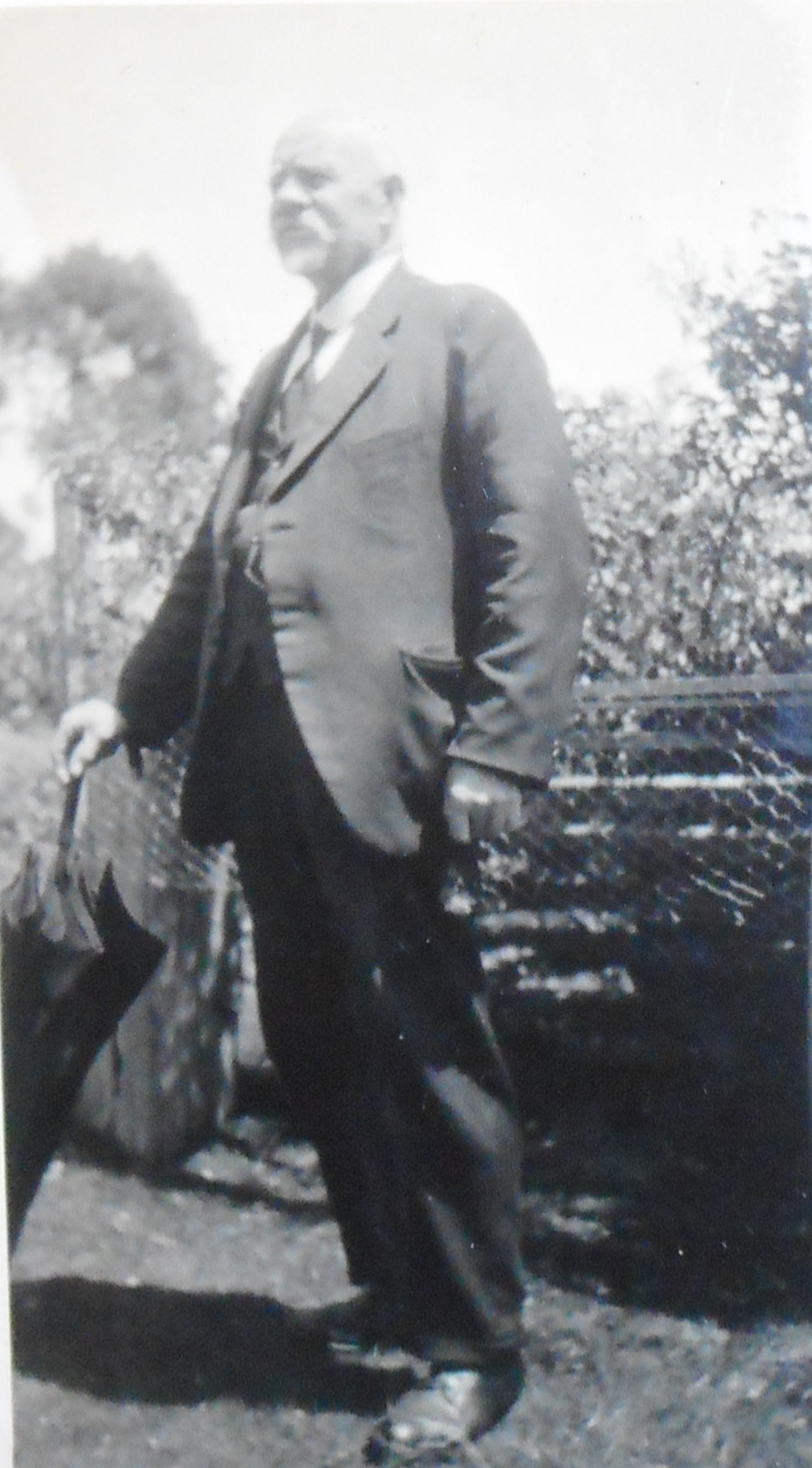
by Nic Haygarth | 23/05/25 | Story of the thylacine
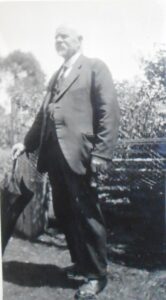
James ‘Tiger’ Harrison, Wynyard native animals dealer, snarer, prospector, track cutter, estate agent, shipping agent, Christian Brethren registrar, tourist chauffeur, human ‘cork’ and Crown bailiff of fossils. Photo from the Norman Larid files, NS1143, Tasmanian Archives (TA).
In the mid-1920s thylacines were still reported by bushmen in remote parts of the north-west. Luke Etchell claimed there was a time when he caught six or seven ‘native tigers’ per season at the Surrey Hills.[1] Like Brown brothers at Guildford, Van Diemen’s Land Company (VDL Co) hands at Woolnorth were still doing a trade in live native animals—although the latter property was out of tigers. On 7 July 1925 Hobart City Council paid the VDL Co £60 10 shillings for what can only be described as two loads of ‘animals’—presumably Tasmanian devils and quolls—recorded as being carted out to the nearest post office at Montagu during the previous month.[2] A further transaction of £30 was recorded in October 1925, when it is possible Woolnorth manager George Wainwright junior hand delivered a crate of live native animals to Hobart’s Beaumaris Zoo.[3]
James ‘Tiger’ Harrison (1860–1943) of Wynyard took his animals dead or alive. He bought and sold living Tasmanian birds and marsupials, including tigers, but also hunted for furs in winter. In July 1926 Harrison and his Wynyard friend George Easton (1864–1951) secured government funding of £2 per week each to prospect south of the Arthur River for eight weeks.[4] However, their main game was hunting: the two-month season opened on 1 July 1926.
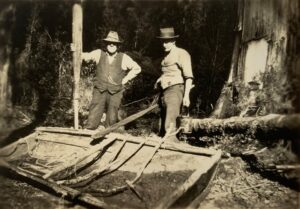
James Harrison’s collaborators George Easton and George Smith with a bark boat used to rescue Easton at the Arthur River in 1929. Photo courtesy of Libby Mercer.

TOPOGRAPHIC BASEMAP FROM THELIST©STATE OF TASMANIA
Easton, an experienced bushman in his own right, made snares most evenings until the pair departed Wynyard on 14 July.[5] At Trowutta Station they boarded the horse-drawn, wooden-railed tram to the Arthur River that jointly served Lee’s and McKay’s Sawmills.[6] Next day, Arthur Armstrong from Trowutta arrived with a pack-horse bearing their stores, and the pair set out along the northern bank of the Arthur towards the old government-built hut on Aylett’s track.[7] However, on a walk to the Dempster Plains to shoot some wallaby to feed their dogs, Harrison injured his knee so badly that he couldn’t carry a pack. So before they had even set some snares the pair was forced to return home.[8] On their slow, rain-soaked journey they sold their stores to the Arthur River Sawmill boarding-house keeper Hayes—the only problem being delivery of said stores from their position up river.[9] While Harrison went home by horse tram and car, Easton had to help Armstrong the packer retrieve the stores.[10]
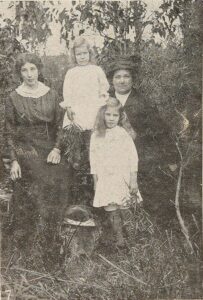
Martha Crole and her daughters. From the Weekly Courier, 10 April 1919, p.22.
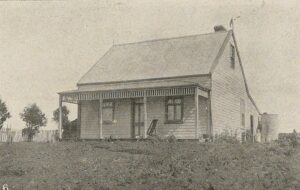
The Crole house at Trowutta. From the Weekly Courier, 10 April 1919, p.22.
‘Tiger country’ around the Arthur River
If not for the injury Harrison may have secured more than furs over the Arthur. One of the European pioneers in that area was grazier Fred Dempster (1863–1946), who appears to have rediscovered pastures celebrated by John Helder Wedge in 1828.[11] Out on his run in 1915 Dempster met a breakfast gatecrasher with cold steel. The elderly tiger reportedly measured 7 feet from nose to tail and being something of a gourmet registered 224 lbs on Dempster’s bathroom scales.[12] In dramatising this shooting, anonymous newspaper correspondent ‘Agricola’ mixed familiar thylacine attributes with the fanciful idea of its ferocity:
This part is the home of the true Tasmanian tiger … This animal must not be confounded with the smaller cat-headed species [he perhaps means the ‘tiger cat’, that is, spotted-tailed quoll, Dasyurus maculatus] so prevalent beyond Waratah, Henrietta and other places. The true species is absolutely fearless in man’s presence, and if he smells meat will follow the wayfarer on the lonely bush tracks for miles, stopping when he does and going on when he resumes his walk. It has been proved beyond question that these brutes will not shift off the paths when met by man, and they will always attack when cornered.[13]
One mainland newspaper was apparently so confused by ‘Agricola’s’ account that he called Dempster’s thylacine ‘a huge tiger cat’.[14]
Trowutta people had no problem distinguishing quoll from tiger. They caught the latter unwittingly while snaring. Fred and Martha Crole and family of Trowutta made hundreds of snares on a sewing machine, eating the wallaby meat and selling the skins they caught. One of their boys, Arthur Crole (1895–1972), landed a tiger alive in a snare, killed it, tanned the hide and used it as a bedside rug.[15] While south of the Arthur, Harrison and Easton were unlucky not to run into Trowutta farmers Fred and Violet Purdy, who caught a tiger in a footer snare there during the 1926 season. When the Purdys approached the captured animal it broke the snare and disappeared. However, tigers also frequently visited their hut south of the river at night and they saw their footprints in the mud next morning.[16] Violet Purdy claimed to have spent six months straight living in the ‘wild bush’ (the hunting season in 1926 was only July and August), and her observations of the thylacine suggest someone with at least second-hand knowledge. Like ‘Agricola’, she knew of the tiger’s reputed habit of refusing to move off a track to let a human pass. Unlike him, she attested to the animal’s shyness. Purdy recommended ‘a couple of good cattle dogs’ as the means of tracking it down. She and her husband found thylacine tracks at the Frankland River as they crossed it to reach the Dempster Plains.[17] Decades later Purdy regaled the Animals’ and Birds’ Protection Board with her tales, illustrating them with a map of ‘tiger country’ between Trowutta and the Dempster Plains.
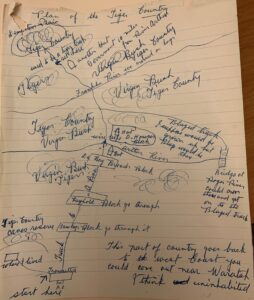
‘Tiger country’ between Trowutta and Dempster Plains, as it looked in 1926, according to Mrs V Kenevan,
formerly Violet Purdy of Trowutta. From AA612/1/59 (TA).
Snaring at Woolnorth
By the time Easton got home to Wynyard, Harrison, apparently recovered from his knee injury, had arranged for them both to snare at Woolnorth, where no swags needed to be carried, since stores were supplied. The VDL Co employed hunters every season to kill ‘game’, this serving the dual purpose of saving the grass for the stock and bringing the company income at a time of low agricultural prices. At this time hunters paid a royalty of one in six skins to the company.
Easton’s diary entries give rare insight into a hunting engagement. Harrison and Easton took the train to Smithton and caught the mail truck to Montagu, from which they were borne by chaise cart to the Woolnorth homestead. That night the snarers were put in a cottage generally reserved for the VDL Co agent, AK McGaw.[18] Next day station manager George Wainwright junior showed them their lodgings (tents next to a lagoon which served as the water supply) and how snaring (using springer snares but also neck snares along fences) and skinning were done at Woolnorth. Wainwright, an old hand, claimed to be able to skin 30 animals per hour.[19] Storms, horse leeches, which had a way of attaching themselves to the human scalp, and cutting springers and pegs kept the snarers very well occupied between snare inspections, an 11-km-long daily routine. The game was nearly all wallaby and ringtails, and Harrison and Easton dried their skins not in a skin shed but by hanging them in trees.[20] Bathing meant a sponge bath with a prospecting dish full of cold water—which also constituted the laundry facilities.[21] The last day of the season at Woolnorth was traditionally an all-in animal shoot, after which the season’s skins were baled, treated with an arsenic solution to kill insects and delivered to a skins dealer.[22] In the two-month 1926 season the VDL Co made £493 from the fur industry, a big reduction on the previous year (£1296) when the season had lasted three months.[23]
However, Harrison didn’t last the distance, calling it quits on 13 August after barely two weeks, leaving Easton to carry on alone until the season ended eighteen days later. Their skin tally at 13 August stood at 16½ dozen—198 skins or 99 apiece.[24]
Returning to ‘tiger country’
Once again ‘Tiger’ Harrison was in the wrong place at the wrong time to live up to his nickname. While he was working at tiger-free Woolnorth, timber worker, hunter and sometime miner Alf Forward snared two tigers, one alive, one choked to death by a stiff spring in a necker snare at the Salmon River Sawmill south of Smithton.[25] Forward is said to have exhibited the living one in Smithton before selling it to Harrison.[26] He almost had another live one in the following month, when a tiger detained by Forward’s snare for two days bit his capturer’s hand, thereby effecting its escape.[27]
Harrison eventually decided to cut out the middle-man. From 1927 he conducted expeditions specifically to obtain living thylacines to sell. He had no luck until in June 1929 he caught one 3 km south-west of Takone.[28] The Arthur River catchment remained ‘tiger country’ in the mid-1930s when ‘Pax’ (Michael Finnerty) and Roy Marthick claimed to have seen them while prospecting.[29] The question of whether they are there today still entertains Tarkine tourists and the worldwide thylacine mafia.
[1] MA Summers’ report, 14 May 1937, AA612/1/59 H/60/34 (Tasmanian Archives, henceforth TA).
[2 Payment recorded 7 July 1925. On 9 June 1925: ‘W Simpson taken animals to Montagu’; 22 June 1925: ‘W Simpson went to Montagu with load of animals’, Woolnorth farm diary, VDL277/1/53 (TA).
[3] Payment recorded on 13 October 1925. On 4 October 1925 George Wainwright junior and his wife departed Woolnorth for the Launceston Agricultural Show (Woolnorth farm diary VDL277/1/53). It is possible that he took a crate of animals on the train to Hobart.
[4] GW Easton diary, 1 July 1926 (held by Libby Mercer, Hobart).
[5] GW Easton diary, 1–14 July 1926.
[6] GW Easton diary, 15 July 1926.
[7] GW Easton diary, 16 July 1926.
[8] GW Easton diary, 18 July 1926.
[9] GW Easton diary, 23 July 1926.
[10] GW Easton diary, 25 and 26 July 1926.
[11] JH Wedge, ‘Official report of journeys made by JH Wedge, Esq, Assistant Surveyor, in the North-West Portion of Van Diemen’s Land, in the early part of the year 1828’, reprinted in Venturing westward: accounts of pioneering exploration in northern and western Tasmania by Messrs Gould, Gunn, Hellyer, Frodsham, Counsel and Sprent [and Wedge], Government Printer, Hobart, 1987, p.38.
[12] See for example ‘Boat Harbour’, North West Post, 22 February 1915, p.2. Dempster probably didn’t have any bathroom scales with him. Rather mysteriously, the author of ‘A huge tiger cat’, Westralian Worker, 19 March 1915, p.6, put the animal’s weight as ‘2 cwt’ (224 lbs).
[13] ‘Agricola’, ‘Farm jottings’, North West Post, 24 February 1915, p.4. In another column ‘Agricola’ claimed with equal dubiousness that under Mount Pearse trappers caught tigers in pits, and that if more than one tiger was collected in the same pit at the same time the captured animals would fight to the death. See ‘Agricola’, ‘Farm jottings’, North West Post, 10 July 1914, p.4.
[14] ‘A huge tiger cat’, Westralian Worker, 19 March 1915, p.6.
[15] Fred and Graham Crole, in Women’s stories: different stories—different lives—different experiences: a Circular Head oral history project (compiled and edited by Pat Brown and Helene Williamson), Forest, Tas, 2009, p.192.
[16] The hut was on Aylett’s Track to Balfour.
[17] Violet Kenevan, Kingswood, New South Wales, to secretary of the Animals’ and Birds’ Protection Board, 30 October 1956, AA612/1/59 (TA).
[18 GW Easton diary, 27 July 1926.
[19] GW Easton diary, 30 July 1926.
[20] GW Easton diary, 18 August 1926.
[21] GW Easton diary, 15 August 1926.
[22] GW Easton diary, 31 August and 6–9 September 1926; Woolnorth farm diary, 31 August 1926, VDL277/1/54 (TA).
[23] The figures are from VDL129/1/7 (TA).
[24] GW Easton diary, 13 August 1926.
[25] ‘Hyena choked in snare at Salmon River’, Circular Head Chronicle, 11 August 1926, p.5.
[26] ‘TT, from New Town’, ‘Tasmanian tiger’, Mercury, 24 August 1954, p.4, claimed that Alf Forward caught the animal in a kangaroo snare at the Salmon River ‘less than 30 years ago’ and sold it to Harrison after putting it on show in Smithton.
[27] ‘Hand bitten by a hyena’, Circular Head Chronicle, 29 September 1926, p.5.
[28 GW Easton diary, 17 June 1929; Circular Head Chronicle, 29 May 1929.
[29] See ‘Pax’ (Michael Finnerty), ‘A “bush-whacker’s” experience in the north-west’, Mercury, 6 May 1937, p.8; Roy Marthick to the Fauna Board, 10 February 1937 (TA); Roy Marthick quoted by Charles Barrett, ‘Out in the open: nature study for the schools’, Weekly Times (Melbourne), 10 July 1937, p.44.
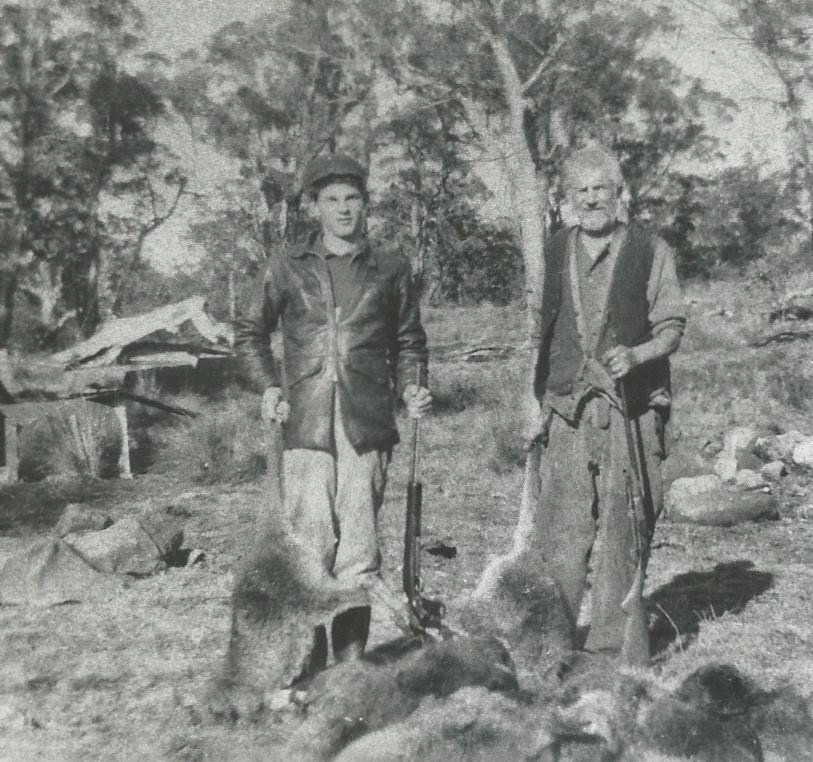
by Nic Haygarth | 06/10/24 | Tasmanian high country history
The collection of farms known as Narrawa in north-western Tasmania produced some tough old buggers. The small community west of Wilmot was home to the Carters, Vernhams, Williamses, Bramichs, Lehmans and others, bush farmers resigned to grubbing out, burning and stump jacking their way to cleared pasture. Crops like potatoes were planted in the ashes of the burnt trees as the beginning of farming operations.
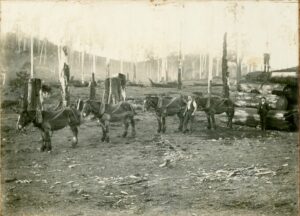
Jack (aka Johnny) Carter, Bill ‘Yorky’ Smith and Jack ‘Boy’ Griffiths clearing land at Narrawa. Griffiths, standing precariously on the log stack, was later killed in a similar operation on the Williams farm. Courtesy of Peter Carter.
After the harvest came the hunt. This was a chance to earn enough money to keep self and family for the rest of the year. Each hunter had his own territory somewhere in the north-western highlands.
Harry ‘Poke’ Vernham/Vernon/Varnham (c1885–c1954)[1]
By the age of 20 Narrawa farmer Charles Henry Vernham already knew his way around Cradle Mountain, being conscripted in the search for hunter Bert Hanson who had gone missing near there in a winter fog.
[2] Harry excited more legends than probably any other bushman in his neck of the woods. He was a small man who, paradoxically, wore sandshoes (sneakers) in the bush. Harry was ‘square as a brick’ but so tough ‘you could drive nails into him and you wouldn’t hurt him’.
[3] Two stories bear out his toughness. In the snaring season of 1906 Harry cut his knee with an axe in the snow at Henrietta south of Wynyard. He covered the wound with salt and bandaged it with a green wallaby skin, telling his hunting partner ‘You’ll have to do all the snaring. I’ll peg out the skins and do all the cooking’.
[4] Eventually Harry presented himself to a doctor, who told him that he was just in time to prevent the onset of gangrene.
[5] Harry was then admitted to the Devon Cottage Hospital at Latrobe.
[6] Hearing of her son’s accident, Harry’s mother walked about 30 km from Wilmot to Latrobe to prevent a surgeon amputating his leg. She succeeded, but Harry was left with a stiff leg for the rest of his life.
[7]
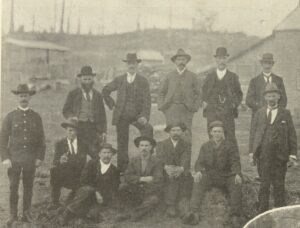
A young Harry Vernham sitting second from right in the second Bert Hanson search party, Weekly Courier, 30 September 1905, p.20.
On another occasion Harry’s nose was virtually detached from his face in a motorcycle accident.
[8] A doctor told him, ‘I’d better give you a whiff of something before I stitch it back on’. Harry is said to have replied, ‘I didn’t have a whiff when it come off so I don’t need one putting it back on’.
[9]
Hunting exploits
In 1914 Harry married Annie Eliza Carter, from the neighbouring family.
[10] They had a boy and three girls over the next four years, but Harry’s nickname Poke suggests that his sex life didn’t end there. At least the hunting seasons were celibate. Harry and his brother George Matthew ‘Native’ Vernham (1889–1966)
[11] had a hut on the south-eastern side of Mount Kate and a little log hut near the site of the present-day Cradle Mountain Lodge, the latter being pretty schmick as it was a lock-up affair.
[12] Other Harry Vernham hunting companions included Ernest ‘Son’ Bramich (1914) and Harry Leach (1933).
[13] Ted Murfet recalled camping with Harry in later years at Middlesex Station, the Twin Creeks Sawmill huts, the hut at Learys Corner, Daisy Dell and Robertson’s on the track into the Vale of Belvoir.
[14] They took a dozen balls of hemp for a season and used an old eggbeater to make up their treadle snares on a board about 1.2 m long. Usually they’d need 1000 snares for the season. In their worst season the pair shared £300 and in their best the take was £700—£350 each.
[15] By this time Harry had moved beyond the medicinal qualities of a green wallaby skin, developing new home remedies. He treated an ulcer on his leg with a plaster of onion wrapped up in a sock as a bandage and addressed a cold with swigs of Worcestershire sauce.
[16]
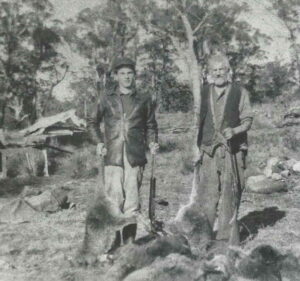
Harry Vernham (right) hunting much later in life. Courtesy of David Ball.
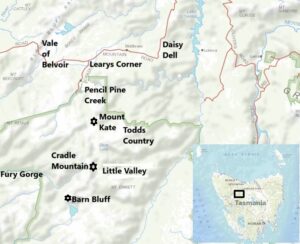
TOPOGRAPHIC BASEMAP FROM THELIST© STATE OF TASMANIA
The slow farm development ritual undertaken at Narrawa also applied to the Connell family when they took up the Dunlavin property at the top of Chinamans Hill, Lower Wilmot, in the 1890s. While his older brother Lionel Connell (1884–1960) became a miner, Gordon stayed on the farm.
[18] He married Alice Jacklin in 1911, and the couple had at least four children during the next decade.
[19] In 1915/16 Lionel Connell and Dick Nichols built a hunting hut in the Little Valley, south of Lake Rodway, and in 1917, when Lionel took a 3-month sabbatical from the Shepherd and Murphy Mine to go hunting, his younger brother Gordon joined him at Cradle.
[20] Known as Bull because of his huge shoulders and great physical strength, Gordon hunted with Lionel as far south as the plains between Barn Bluff and the Fury River. He also worked over the so-called Todds Country at the head of the Campbell River.
[21] Gordon had a big kangaroo dog called Slocum which would take him to his kills. One day Gordon put his feet up and smoked for 30 minutes before Slocum returned. ‘Where is he then?’, the master prompted, setting the dog off towards Lake Carruthers to a big kangaroo he’d killed. But Slocum wasn’t finished, refusing to budge. ‘Well where is he then?’. Off they went again beyond Lake Carruthers to another big kangaroo carcass.
[22]
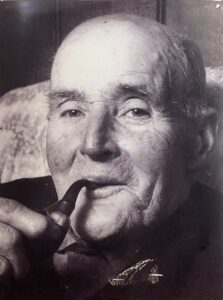
Gordon Connell, courtesy of Malcolm Dick.
Gordon hunted with Harry Vernham at Cradle in 1925 and 1926 and in other years around Middlesex and the Vale of Belvoir.
[23] They developed a regime of line camps or temporary shelters to get around their extensive snare lines, arriving at base camp only every three days. Gordon recalled icicles forming on Harry’s formidable body hair as he lugged his bag of skins about the snare lines. When Harry stripped off his shirt a huge cloud of steam arose from his singlet, an unusual form of enveloping fog. Wild bulls remaining from Field brothers’ Middlesex grazing operation were an occasional problem for hunters. The worst of these was a territorial bull called Bob because of the ‘bob’ in his tail. Another bull they put a bullet in roared back to life as they approached its apparent corpse. Gordon had a way of cutting a cartridge with a knife to concentrate its potency, but on this occasion it seems to have had the opposite effect.
[24]
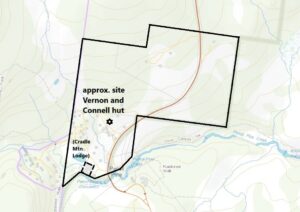
The Vernham and Connell 99-acre block at Pencil Pine Creek. TOPOGRAPHIC BASEMAP FROM THELIST© STATE OF TASMANIA
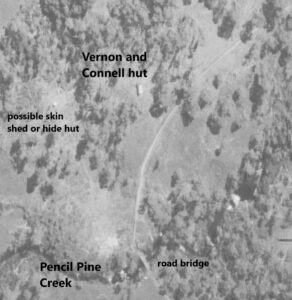
How the area looked in 1949, showing the position of the hunting hut. Crop from aerial photo 0196_483, 15 April 1949.
In the 1930s Poke and Bull selected and started to pay off a 99-acre-block at Pencil Pine Creek enclosing the log hut and the old FH Haines sawmill site—land now partly occupied by Cradle Mountain Lodge, the Cradle Mountain shop and rangers’ quarters. Presumably they were either safeguarding their hold on valuable hunting territory or foresaw future tourism development. The pair failed to pay it off, and Lionel and Margaret Connell took over the payments. Lionel’s family were still using the log hut in 1940. Like most hunting huts in the area it had a skin shed chimney, that is, a very large timber chimney in which skins were pegged to dry close to the fire.
[25]
The tiger stories
Peter Carter, Harry Vernham’s nephew, claimed that Harry caught thylacines (Tasmanian tigers) in ‘hell-necker’ or ‘hellfire necker’ snares positioned at each end of a hollow log that contained a live wallaby. The ‘hellfire’ appears to have been a heavy-duty neck snare—not terribly surprising, as plenty of tigers were strangled in neck snares. What is surprising is Peter’s claim that his uncle sold skun tigers, that is, tiger carcasses, for £5. Perhaps he meant that he sold tiger skins for £5.
[26] Harry Vernham’s name was never entered on the list of payees for the £1 per head government thylacine bounty, although it is possible he claimed bounties through an intermediary. Still, the question needs to be asked why he went to so much trouble to strangle a tiger in a neck snare, when he could just have easily snared it alive by the paw in a foot or treadle device which would have earned him much more money. The story would only make sense if Harry had learned the whereabouts of a tiger or family of tigers and set up the hollow log trap as above, making sure the wallaby was restrained so that it couldn’t spring the snares while making its escape. Prices paid for tigers, dead or alive, varied wildly, so it’s hard to put even an approximate year on Vernham’s tiger sales.
[27]
Gordon Connell is another name missing from the government tiger bounty register. He once caught a thylacine dead in the snare—presumably a necker snare which strangled it—but he encountered others in the wild. Bull was said to have found a thylacine lair in one of three rock shelters down in the Fury Gorge while hunting nearby. He shouldn’t have been surprised then when, hunting the button-grass plains above it out of season, he heard an animal yelp. A big kangaroo hopped up the slope, as if disturbed, convincing Gordon and his mate that the police were below them. Then a tiger came up the slope in pursuit of the kangaroo. At regular intervals it stopped and gave three sharp yelps before continuing the chase, as did a second tiger behind it.
[28]
What a pity neither Poke nor Bull put pen to paper! We know so little about hunters’ experiences with tigers, but at least these anecdotes give glimpses of what they passed down through family and the hunting community.
[1] Years of birth and death are from Ancestry.com.au, no birth certificate or will was found.
[2] ‘Lost in the snow: a second search party’,
North Western Advocate and the Emu Bay Times, 25 July 1905, p.3.
[3] Peter Carter, interviewed by David Bannear, 16 July 1990, in
What’s the land for?: people’s experiences of Tasmania’s Central Plateau region, Central Plateau Oral History Project, Hobart, 1991, vol.3, p.4.
[4] Warren Connell, interviewed 8 September 1997; David Ball, interviewed 25 April 2020.
[5] Warren Connell.
[6] ‘Latrobe’,
North Western Advocate and the Emu Bay Times, 29 August 1906, p.2.
[7] Len Fisher,
Wilmot: those were the days, pp.46–47
[8] ‘Ulverstone’,
Advocate, 26 March 1934, p.6.
[9] David Ball, 24 April 2020. Ted Murfet also told this story to Len Fisher in
Wilmot: those were the days, the author, Devonport, 1990, p.82.
[10] Married 15 October 1914, marriage record no.801/1914, registered at Wilmot (TA).
[11] Born to Blackwood Hill, West Tamar labourer William Varnam [sic] and Christina Bowers on 1 February 1889, birth record no.736/1889, registered at Beaconsfield, RGD33/1/68 (TA),
https://librariestas.ent.sirsidynix.net.au/client/en_AU/names/search/results?qu=george&qu=varnham, accessed 3 October 2023; died 7 February 1966, Will no.47656, AD960/1/105 (TA),
https://librariestas.ent.sirsidynix.net.au/client/en_AU/names/search/results?qu=george&qu=vernham, accessed 3 October 2023.
[12] Gustav Weindorfer diary, 12 July 1914 (Pencil Pine Creek), 23 July 1914 (east side Mount Kate), NS234/27/1/4 (TA); 10 July and 10 August 1925 (Pencil Pine Creek) (QVMAG). Es Connell, interviewed by Nic Haygarth on 23 September 1997, confirmed the location of this hut.
[13] Gustav Weindorfer, in his diary, 16 and 18 June 1914, NS234/27/1/4 (TA), recorded Harry Vernham and Bramich hunting Cradle Valley and Hounslow Heath with dogs. For Leach see ‘Taking game in close season alleged’,
Advocate, 12 September 1933, p.2.
[14] Ted Murfet, interviewed 15 October 1995.
[15] Ted Murfet, interviewed 15 October 1995.
[16] Ted Murfet, in Len Fisher,
Wilmot: those were the days, the author, Devonport, 1990, p.81.
[17] Born 29 April 1889 to Michael Connell and Frances Sayer, birth registration no.2639/1889, registered at Port Frederick, RGD33/1/68 (TA),
https://librariestas.ent.sirsidynix.net.au/client/en_AU/names/search/results?qu=gordon&qu=murray&qu=connell#, accessed 18 August 2024. The family was living at Torquay (East Devonport).
[18] Commonwealth Electoral Roll, Division of Wilmot, Subdivision of Kentish, 1914, p.10;
Wise’s Tasmanian Post Office Directory, 1919, p.277.
[19] Married 28 March 1911, file no.1384/1911, registered at Gunns Plains (TA).
[20] Gustav Weindorfer diary 29 December 1915 (Lionel Connell and Dick Nichols arrive at Cradle from Moina), NS234/27/1/5 (TA); 1–26 April 1917, NS234/27/1/7 (TA). Weindorfer possibly also referred to Gordon Connell in diary entries in May and June 1917, NS234/27/1/7 (TA).
[21] Todds Country was a name given by snarers to territory hunted by Bill Todd (1855–1926).
[22] Warren Connell.
[23] Gustav Weindorfer diary, 14 July 1925 and 23 March 1926 (QVMAG).
[24] Warren Connell.
[25] RE Smith diary, 29 June 1940, NS234/16/1/40 (TA).
[26] Peter Carter, p.10.
[27] For example,in James 1928 Harrison sold a tiger carcass to Colin MacKenzie in Melbourne for £12 (Harrison’s notebook). In 1930 Wilf Batty sold the carcass of the tiger he killed at Mawbanna for £5 (Wilf Batty; quoted in ‘The $55,000 search to find a Tasmanian tiger’,
Australian Women’s Weekly, 24 September 1980, p.41).
[28] Warren Connell.
by Nic Haygarth | 10/08/24 | Story of the thylacine
At Pisa Cemetery the Parkers, O’Connors, Gatenbys and Smiths are all equals. Some of course are more equal than others, having large, decorated headstones and obelisks, but their bones moulder in the same clay and their spirits, should they have any, mingle on the same windswept plain rolling back to the blue profile of the Great Western Tiers. It is remarkable that the graves of John (c1822–1903) and Hannah Jane Smith (c1819–1903) are marked at all. It doesn’t get more anonymous than being John Smith, and the anonymity of a bare patch between the plinths of their betters awaited most of the likes of these two. Perhaps their old employer Roderic O’Connor (1849–1908) gave them a monument as a mark of respect.
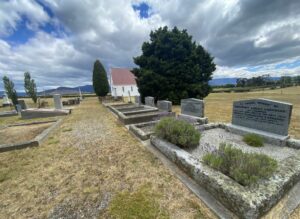
Pisa (St Mark’s Anglican, Lake River) Cemetery. Nic Haygarth photo.
The irony of that action wouldn’t have been lost on John Smith, one of 314 bearers of that name conscripted to Van Diemen’s Land. A native of Nottingham, Jack was a single, semi-literate, 170-cm-tall labourer when sentenced to 7 years’ transportation for stealing a pair of shoes and a hatchet as a 20-year-old in 1842. The hatchet was a token of a combative life. He had a prior conviction and five short prison terms under his belt, being, apparently, ‘a bad irreclaimable lad, connected to other lads who live by plunder’. Transported on the Forfarshire, he appears to have laboured in a probation gang at Westbury before his attempts to abscond landed him in the Port Arthur Gaol. Jack spent 3½ years in the probation system, enduring 179 lashes, 88 days of solitary confinement and 21 months of hard labour in chains before being released for private service in 1847 at the age of about 25. What would his opinion have been at that time about whether transportation was a sentence or an opportunity?
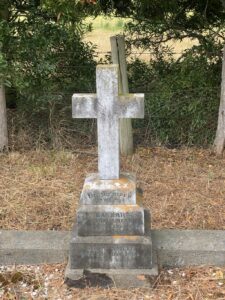
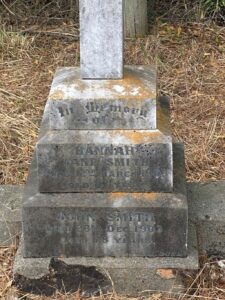
The monument marking the graves of John and Hannah Jane Smith, Pisa Cemetery. Nic Haygarth photos.
Jack then worked for Edward Archer of Northbury, Longford (nearly two years), and Joseph Oakley of Oatlands, achieving freedom by servitude at the expiry of his sentence in 1849.[1]
Perhaps he still brandished that hatchet, because within a few years Jack was living by plunder once more, working out of a hide-out near Millers Bluff. Known as ‘Jack the Hunter’, in the mould of the Irish outlaw ‘Jack the Shepherd’, he was accused of rustling sheep from the large properties adjoining the slopes of the Great Western Tiers. In 1856 graziers Arthur O’Connor of Connorville and Charles Parker of Parknook tracked him down and sent a volley his way. Jack raised his weapon at O’Connor but it failed to discharge, and he made his escape.[2] The threat Jack posed to wool-growing was raised in parliament.[3] An armed police party sent to apprehend him mistakenly pounced on a roving entomologist at the Hummocky Hills.[4] A posse led by District Constable Thomas Kidd of George Town did better, finally arresting Jack the Hunter or ‘Hellfire Jack’[5] at Hells Bottom on the slopes of Millers Bluff in 1858. Here they also found the evidence of his ovine crimes in a veritable maze of hideouts, including an underground wool store. Jack was shot in the arm while trying to escape, newspaper reports varying in their accounts of his injuries.[6] His victims, the Gatenbys and O’Connors, secured two of his hunting dogs as a form of recompense.[7] The ex-convict was sentenced to four years’ gaol for stealing 15 sheep worth £8 from George Gatenby of Barton.[8]
In 1870 a newspaper writer recounting Jack’s tale commented that ‘Poor Jack, now in confinement, must look back with harrowing regret to his wild hut high on the tier’.[9] In fact Jack was already back on the tier.[10] Somehow Arthur O’Connor had forgiven his depredations and allowed him back onto Connorville—presumably as a shepherd! After all, there’s no substitute for local knowledge. Jack’s residence was Boomers Bottom, a sheep run where the Lake River cut a passage down through the mountains. Adam Jackson’s 1847 survey of the upper Lake River didn’t recognise Hells Bottom but mapped Scrubby Den and the even more tantalising Tigers Bottom.
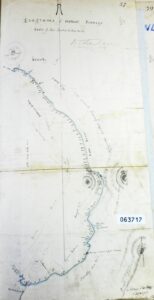
Adam Jackson’s 1847 survey of the upper Lake River where there be tigers. Copyright State of Tasmania.
Jack was certainly at Connorville in 1885 when ‘Jimmy the Sailor’ Casey saved his five-year-old from drowning in the mill race.[11] But Jack was more than a father and a hunter: he was a serial thylacine decapitator. He buried his hatchet in tigers’ necks. The submission of severed animal heads to unsuspecting public officials sounds like something out of The Godfather.[12] However, this seems to have been acceptable behaviour at the time. At least twelve thylacine heads were presented to the Longford warden or police office for payment in the years 1888–97, Connorville and Parknook being star killing fields.[13] Jack produced eight of these, probably securing them in necker snares.[14] In 1897 he claimed to have killed about 130 tigers during 30 years’ residence at Boomers Bottom.[15] It is possible that Jack managed a line of necker snares across a gully through which tigers were thought to be entering the Connorville property, in the fashion of the Woolnorth ‘tigerman’ at Green Point in the far north-west. Even so, four tigers per year hardly constitutes an invasion, and we do not know if any of those 130 savaged any of Connorville’s 14,000-strong grazing flock.[16]
Jack’s partner Hannah Jane Smith predeceased him by nine months.[17] Her story, like those of so many other anonymous wives and female partners, is unknown. Their child or children are also untraceable, their births seemingly evading the registrar. Perhaps Hannah helped Jack secure his sixteen £1 government tiger bounties.[18] That would have paid for some sugar, tea, tobacco and snaring hemp or wire but not saved them from kangaroo leather ensembles and a diet of macropod and potato. Perhaps Jack’s hunting was a lot more lucrative than that in the backblocks of Connorville. Perhaps Jack and Hannah lived at a distance in mutual contempt. We will never know. They keep their secrets beneath the loam at St Mark’s, Lake River, where the tigers once roamed.
[1] Conduct record for John Smith per Forfarshire, CON33/1/44, p.197 (Tasmanian Archives, afterwards TA), https://libraries.tas.gov.au/Digital/CON33-1-44/CON33-1-44p197; Conduct record for John Smith per Forfarshire, CON37/1/9, image 216 (TA), https://libraries.tas.gov.au/Digital/CON37-1-9, both accessed 4 August 2024.
[2] ‘Bushranging’, Launceston Examiner, 18 September 1856, p.3.
[3] ‘House of Assembly—last night’, Courier, 9 October 1858, p.2.
[4] ‘An Old Vet’, ‘Jack the Hunter: an episode in a VDL policeman’s life’, Daily Telegraph, 4 January 1895, p.6.
[5] ‘Capture of another bushranger’, Courier, 8 October 1858, p.3. ‘Hellfire Jack’ was also the nickname of the ex-convict John Snelson.
[6] ‘Bushranging in Tasmania’, Courier, 8 October 1858, p.3.
[7] George Gatenby diary, 31 August and 1 September 1858, NS1255/1/1 (TA).
[8] ‘Oatlands Supreme Court’, Hobart Town Advertiser, 3 January 1859, p.7.
[9] ‘Aegles’, ‘Notes in north Tasmania’, Launceston Examiner, 15 February 1870, p.5 (reprinted from the Leader [Melbourne]).
[10] ‘Longford Police Court’, Launceston Examiner, 9 February 1897, p.5.
[11] ‘Cressy’, Mercury, 22 September 1885, p.4.
[12] The Godfather, a 1972 movie directed by Francis Ford Coppola, included a scene in which a severed horse’s head was placed in the bed of a sleeping man.
[13] Longford notes’, Launceston Examiner, 2 August 1888, p.5; ‘Longford notes’, Launceeston Examiner, 2 July 1889, p.4; ‘Police Court’, Launceston Examiner, 13 March 1890, p.3; ‘Longford’, Mercury, 4 October 1890, p.2; ‘Current topics’, Launceston Examiner, 30 September 1891, p.2; ‘Country intelligence’, Tasmanian, 27 August 1892, p.30; ‘Longford’, Tasmanian, 10 June 1893, p.2; ‘Longford Police Court’, Launceston Examiner, 9 February 1897, p.5.
[14] ‘Longford’, Launceston Examiner, 13 March 1890, p.3; ‘Longford notes’, Tasmanian, 4 October 1890, p.22; ‘Country intelligence’, Tasmanian, 27 August 1892, p.30; ‘Longford’, Tasmanian, 10 June 1893, p.22;
[15] ‘Longford Police Court’, Launceston Examiner, 9 February 1897, p.5.
[16] The size of the sheep flock is from E Richall Richardson, ‘A tour through Tasmania (letter no.73): Connorville’, Tribune, 12 November 1877, p.2.
[17] Headstone, Pisa Cemetery.
[18] Bounties no.582, 17 December 1889; no.81, 18 March 1890; no.354, 20 August 1890; no.463, 7 October 1890; no.62, 26 March 1891; no.184, 22 May 1891; no.822, 1 April 1892; no.272, 12 September 1892, LSD247/1/1; no.123, 19 June 1893 (2 adults); no.13, 5 March 1895; no.37, 30 [sic] February 1896; no.39, 5 March 1897 (3 adults); no.45, 17 March 1898 (‘2 March’), LSD247/1/2 (TA).
by Nic Haygarth | 09/03/24 | Circular Head history
Lasseter’s Reef wasn’t the first pot of gold to go missing.[1] Many goldfields have their holy grails, the tale of a fabled reef found but then lost, tantalising generations of prospectors. On Tasmania’s Arthur River it was the reputed reef at the Blue Peaked Hill,[2] but even ‘Australia’s biggest dairy farm’ Woolnorth, in the state’s north-western corner, wears a tale of gilded woe.
The unlikely claimant at Woolnorth was John Elmer (1801–80), who is said to have been born at Barnham, St Edmundsbury Borough, in Suffolk, England. He married Frances Kemp in that town in 1823.[3] On 22 March 1832, along with their four daughters and five other men, they arrived at Stanley on the barque Forth as indentured servants to the Van Diemen’s Land Company (VDL Co).[4]
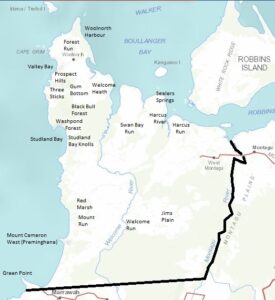
The Woolnorth property showing its original eastern boundary. TOPOGRAPHIC BASEMAP FROM THELIST copyright STATE OF TASMANIA
The settlement on the coast at Woolnorth Point was then only three years old, consisting of a store, six cottages, a stable, a blacksmith’s shop and a jetty where produce could be loaded and goods landed.[5] The place was isolated, conditions primitive and rations meagre. Indentured servants were required to stay long enough to work off their passage fares, but three Forth arrivals and two other indentured servants voted with their feet by absconding in October 1832.[6] The Elmers stayed, John’s employment even surviving an incident in October 1834 when he struck Woolnorth overseer Samuel Reeves during a pay dispute.[7] A splash of gold across the drudgery of tending Saxon ewes, draining marshland, milking cows and keeping house would have been welcome.[8] However, nobody entertained ideas of a gold bounty in the years before the Californian rushes of 1848–55. Few would have known gold if they fell over it.
Shepherd at Woolnorth and Cheshunt
The Elmer family endured a decade at remote Woolnorth before taking up a Launceston butchery.[9] That move landed John Elmer in the Insolvency Court, after which he appears to have joined the wool-grower, architect and botanist William Archer IV’s Cheshunt property south-west of Deloraine.[10] Elmer would have been an interesting witness on the subject of thylacine predation on sheep, having been a shepherd at a time when few attacks were reported at either Woolnorth or Cheshunt. In 1851, when Elmer was hired or rehired as a Cheshunt shepherd and overseer at an annual salary of £40, he and Frances already had a family of six young children.[11]
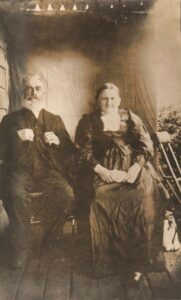
James (Edward James) Elmer and his wife Louisa Annie Diprose. Courtesy of Bruce Hull.
James Elmer
One of their offspring was Edward James Elmer (c1835–1916), who called himself James Elmer.[12] He claimed to be ‘the oldest white born under the VDL Company’. Many seventeen-year-olds must have raced off to the goldfields at Forest Creek, Loddon River or Creswick with their fathers circa 1852 when the mosquito fleet plying Bass Strait was laden with garrulous Van Diemen’s Land diggers. No shipping records place John or James Elmer among them.[13] A tour of the Victorian goldfields would have guaranteed the Elmers a familiarity with the appearance of alluvial gold and the conditions under which it was found. But it seems they stayed home keeping sheep and saving their pennies to take up a tenant farm at Cheshunt.[14]
A deathbed confession
John Elmer died as a supposedly senile 78-year-old at Bridgenorth, West Tamar in 1880.[15] On his deathbed he told James that at Woolnorth he’d done more than keep tigers from the sheep, having found ‘plenty of gold’.[16] The question of how exactly a Suffolk shepherd could have recognised gold a decade or two before the global gold bonanza began doesn’t seem to have fazed James. Nor did his father’s prescribed senility. Then there was the matter of why John Elmer—assuming he was literate—hadn’t exploited the reef himself by, for starters, sending rock samples to an assayer or a geologist. James’ problem was that he had developed a touch of gold fever, which is exactly what happened when you hung around with that ne’er-do-well Henry Weeks.
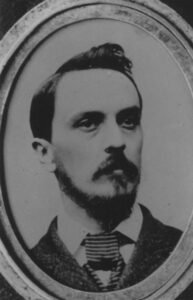
Chief Chummy’s gold chaser Henry Weeks. Courtesy of John Watts.
Henry Weeks and Chummy’s gold
Native Rock farmer Weeks (1832–99) was a staunch Rechabite.[17] His weakness didn’t come in a bottle but with a geological pick: he lost his nut to mineral prospecting and mining investment. Weeks had also missed the Victorian gold rushes, only arriving in Van Diemen’s Land from Monmouth, Wales, as an assisted immigrant coalminer in 1854.[18] He must have made up for lost time. Weeks’ discovery of the rich Mount Claude (Round Hill) galena mine in 1881 distracted him from the farm but did nothing for his bank balance.[19] Chasing Chummy’s gold didn’t help much either. This Lasseter’s Reef story involved George ‘Chummy’ Webb finding a fabulous gold reef in the Forth River high country—and taking the location to the grave with him, leaving his mate Henry Weeks to rediscover it. The only surviving clue to the site, ‘with the Western Tiers behind you and Cradle in front of you’, led all comers on a merry dance.[20]
The VDL Co goes mining
Weeks wasn’t alone in taking this tack. Frustrated by poor farming returns and tantalised by rich metal discoveries just outside its property, in 1882 the VDL Co began to examine its holdings for minerals.[21] Weeks or James Elmer evidently got wind of this, and with Henry Cooper put their names to a proposal to the company. The spelling is James Elmer’s:
‘I have been told that you want some party to prospect the companys land at Woolnorth if so we wold like to take the work, as have some knowledge of the place and my Father found gold thare fifty years ago and when he was dyen he told me as near as he cold were it was. My Father was shepherd there for manney years. I was down thare some few years ago and my mates got tired before we got thare and wold not stay when we got thare so wold not stop we are astickon [sic] party now thare are three of us but only two will be abell to go at a time. If you will let me know what terms we will try and agree as we wold mutch like to go down and find the big reef for thare is plenty of gold down there. We have all had a deal of practice in mining fore gold …’[22]
No VDL Co response has been found. After decades of dealing with mostly lackadaisical prospectors, VDL Co local agent James Norton Smith probably never took Elmer’s proposal seriously. The company’s prospector, a Cornishman named James Rowe, later found nothing of value at Woolnorth or any other VDL Co property, advising it to give up prospecting.[23]
Chummy keeps his secret
James Elmer didn’t give up. He still had the bug two decades later as a 70-year-old, repeating his father’s tale to Norton Smith’s successor Andrew Kidd McGaw:
‘I wold like to go and see if I cold find it. I wold have to drive down and cannot walk as I cold 50 years ago but am [not] a crippel yet. My horse wold do on the run aney ware so long as I got my tucker down. If I can go I will call and see you as am goen down I wold like to go soon …’[24]
This time James Elmer got there. The Woolnorth farm diary records that on 7 January 1906 Edward J Elmer and son arrived at Woolnorth to go prospecting, leaving nine days later.[25] There was no report of a gold strike.
Chummy also kept his secret. Camped near Bonds Peak in 1918 on a Chummy’s gold mission, Bill Johnson even believed he heard Henry Weeks’ ghost try to give him directions.[26] Hobart mining investor EC James was still searching for Chummy’s gold in the years 1925–30. James believed the gold may have been somewhere near Mount Emmett in today’s Cradle Mountain-Lake St Clair National Park.[27] Just as Harry Bell Lasseter’s central Australian mirage still triggers adventurers, revival of the Stormont Gold Mine in 2014 stirred the legend of Chummy’s gold.
No gold-bearing quartz reef is known to exist at Woolnorth. If John Elmer did find one, his discovery would pre-date that of John Gardiner (aka James Roberts), who claimed to have struck gold in a limestone quarry on Cabbage Tree Hill near latter-day Beaconsfield in 1847.[28] This has been cited as the first Tasmanian gold discovery. Gardiner only confirmed that it was gold he had found when he saw the precious metal later on a Victorian goldfield. Perhaps John Elmer had a similar eureka moment years down the track from his Woolnorth days, at Mangana, Mathinna, Lefroy or Beaconsfield, when the spirt was still willing but the body wasn’t up for the rigours of a gold rush.
[1] Harry Lasseter (aka Lewis Hubert Lasseter) died trying to relocate his fabled gold reef in central Australia in 1931.
[2] See Nic Haygarth, ‘SB Emmett: a pioneer Tasmanian prospector, from Bendigo to Balfour’, Circular Head Local History Journal, vol.1, no.1, 2004, pp.36–69.
[3] FHL film no.950448, sourced through Ancestry.com.au.
[4] CSO1/1/591/13412; GO1/1/13, p.517; Edward Curr to Samuel Reeves, 30 March 1832, VDL23/1/5 (Tasmanian Archives, afterwards TA).
[5] ‘Our Own Reporter’ (Stuart Sanderson), ‘The VDL—VIII’, Advocate, 22 December 1925, p.12; Edward Curr to Samuel Reeves, 12 January and 25 September 1832, VDL23/1/4 and VDL23/1/5 respectively; Edward Curr to John Hicks Hutchinson, 11 April 1833, VDL178/1/1 (TA).
[6] Edward Curr to the Court of Directors, VDL Co, London, Outward Dispatch no,230, 15 October 1832, VDL5/1/4 (TA).
[7] John Hicks Hutchinson to Samuel Reeves, 8 November 1834, VDL23/1/6 (TA).
[8] Monthly returns Woolnorth Estate, VDL62/1/1 (TA).
[9] Paylists for Woolnorth, VDL 82/1/1 (TA).
[10] John Elmer was declared insolvent on 15 April 1844 while working as a butcher in Launceston (advert, Launceston Examiner, 17 April 1844, p.5). William Archer was the informant for the birth of Henry Thomas Elmer to John Elmer and Frances Kemp on 31 July 1844, birth record no.410/1844, registered at Launceston, RGD33/1/23 (TA), https://librariestas.ent.sirsidynix.net.au/client/en_AU/names/search/results?qu=frances&qu=kemp&rw=24&isd=true#, accessed 1 July 2023.
[11] William Archer IV diary, 11 July 1851 (University of Tasmania Special Collections, Afterwards UTas).
[12] He was presumably the baby born in October 1835. See Edward Curr to Adolphus Schayer, 28 September 1835, VDL23/1/6 (TA).
[13] Another John Elmer, a free immigrant who arrived in the colony on the Water Witch, departed from Launceston for Melbourne on the brig William Hill on 27 April 1852 (POL220/1/2, p.13, TA). John E Elmer, a free arrival in the colony on the Bee, also sailed from Launceston to Melbourne on the steamer Clarence on 16 November 1852 (POL220/1/2, p.238, TA).
[14] By 1862 both John and James Elmer were tenant farmers on Cheshunt, leasing 170 and 150 acres respectively, William Archer IV diary, 15 April 1862 (UTas).
[15] Died 6 June 1880, death record no.861/1880, registered at Westbury, RGD35/1/49 (TA), https://librariestas.ent.sirsidynix.net.au/client/en_AU/names/search/results?qu=john&qu=elmer, accessed 1 July 2023; ‘Another old colonist gone’, Launceston Examiner, 9 June 1880, p.2.
[16] James Elmer, Henry Weeks and Henry Cooper to James Norton Smith, VDL Co, 12 June 1883, VDL22/1/11; James Elmer, Kimberley, to Andrew Kidd McGaw, VDL Co, 17 December 1905, VDL22/1/36 (TA).
[17] The Independent Order of Rechabites was a friendly society which encouraged abstention from alcohol. Weeks’ property Native Rock was near latter-day Railton.
[18] Descriptive list of immigrants for the Merrington. CB7/12/1/2, book 20, p.330 (TA), https://librariestas.ent.sirsidynix.net.au/client/en_AU/names/search/results?qu=henry&qu=weeks&qf=NI_INDEX%09Record+type%09Arrivals%09Arrivals+%7C%7C+Departures%09Departures, accessed 3 March 2024. Both Henry and his wife Priscilla were literate Wesleyans. Resident Mersey–Don River coalminer Zephaniah Williams applied to bring them to the colony along with other coal-mining families to work for the Mersey Coal Company.
[19] ‘Auction sales’, North Coast Standard, 17 July 1894, p.3. Bankruptcy forced Weeks to sell four properties.
[20] See, for example, ‘Lorinna’, Daily Telegraph, 11 January 1911, p.2.
[21] See Nic Haygarth, ‘Mining the Van Diemen’s Land Company holdings 1851–1899: a case of bad luck and clever adaptation’, Journal of Australasian Mining History, vol.16, October 2018, pp.93–110.
[22] James Elmer, Henry Weeks and Henry Cooper to James Norton Smith, VDL Co, 12 June 1883, VDL22/1/11 (TA).
[23] James Rowe, ‘Report of Captain James Rowe’, 1886, VDL334/1/1 (TA).
[24] James Elmer, Kimberley, to Andrew Kidd McGaw, VDL Co, 17 December 1905, VDL22/1/36 (TA).
[25] VDL277/1/34 (TA).
[26] Graham Riley, Sheffield, interviewed 23 May 1993.
[27] EC James, ‘Forth Valley prospecting’, Mercury, 8 April 1925, p.12; EC James, ‘An old gold find’, Examiner, 18 December 1929, p.11; EC James, ‘Chumey’s [sic] claim’, Examiner, 4 February 1930, p.9.
[28] See for example ‘Gold in Tasmania’, Mercury, 27 March 1869, p.3.
by Nic Haygarth | 17/06/23 | Tasmanian high country history, Tasmanian nature tourism history
While walking the Overland Track between Cradle Mountain and Lake St Clair in 1931, pedestrian extraordinaire ET Emmett found some words scribbled on a pine rafter inside the old mine workers’ hut at Pelion Plain.[1] The scribble authors, Emmett wrote, were ‘members of Mr Jocelyne’s [sic] South African party’, who had recorded details of their seven days’ stay in the area:
‘Scalps taken: Mt Oakleigh, Mr Ossa, Lake Ayr, Mt Thetis, Forth Gorge, Toad Rocks, Pelion East’.[2]
The Joscelyne in question was probably Horace Joscelyne (1878–1965), a Launceston-born grocer’s assistant who visited Cradle Mountain in 1922.[3] But who were the South Africans? Perhaps Horace and his wife Addie showed Tasmania to some South African visitors. Emmett’s 1931 Overland Track party was guided by temporary park ranger Bert Nichols, but the Joscelyne tour was probably from the time of Nichols’ predecessor as highland tour guide, Paddy Hartnett.
The Fred Smithies papers in the Tasmanian Archives[4] contain what is probably a semi-fictional account of the Joscelyne trip with Hartnett. Most of the same ‘scalps’—Mounts Oakleigh, Ossa and Thetis, Lake Eyre [sic] and ‘Pelion’s giant toad’—in the fictional account were ‘taken’ in similar order as outlined on the Pelion hut rafter. Although the story has a more linear structure than ‘A dip into the Waldheim mailbag’ (see earlier blog), it refers to the earlier story and appears to have the same anonymous author. As outlined in the previous blog, the author of the Waldheim mailbag story is likely to be one of Vera May Scott, Lydia Morrison or Addie (Harriet Mary) Joscelyne. It is unknown whether any of these women was a member of Horace Joscelyne’s ‘South African’ party. The candidates for authorship line up like this:
Vera May Scott (1886–1962)[5] was born at Battersea, London. At the 1901 British census she was a 15-year-old living in London with her 47-year-old piano tuner father Henry Sidney Scott and 37-year-old Brisbane-born mother May Scott.[6] No record of the family’s migration was found, but in 1922 Vera May Scott was an unmarried typist living at 28 Delamere Crescent, Trevallyn with her parents and sister Eleanor Scott.[7] Scott lived next door to the Joscelynes and had a strong connection to the family. In 1945 she thanked Horace Joscelyne for ‘unfailing kindness’ during her mother’s long illness.[8] Rupert William Joscelyne Hart, whom Scott recognised in her will, was the son of Horace Joscelyne’s sister Violet Mary Joscelyne.[9]
Lydia Morrison (1886–1971)[10] appears to have emigrated from England as a small child in 1891, along with her two-year-old brother and her parents, 28-year-old Lydia Morrison senior and 35-year-old farmer William Morrison.[11] In 1922 Lydia lived with her parents, her sister Dorothy Mary Morrison and brother William Morrison junior, at 211 St John Street, Launceston.[12] Forty-six years later in 1968 Lydia was still listed as an unmarried clerk—at 82 years of age—and living with her bookbinder sister at 6 Union Street, Launceston.[13]
Harriet (‘Addie’) Joscelyne née Cumings (c1872–1946) emigrated from England with her sister as a teenaged nursemaid in 1888. Her parents, Ebenezer and Caroline Cumings, had preceded her and were already Launceston residents.[14] Addie’s older sister Minnie gave her occupation in the passenger list as schoolteacher, and until her marriage in 1893 she operated the Trevallyn Preparatory School.[15] At this point Addie Cumings took over from her, continuing the school until at least 1897.[16] This suggests that she was at least reasonably well educated. Addie Cumings married Horace Samuel Joscelyne at Launceston in 1903. They had no children.[17]
When did the trip take place?
Details in the semi-fictional account allow us to arrive at a possible time for the trip on which it was based. It was undertaken when the waratahs were in flower, which makes it in the period October to December. The ‘mistress of the more pretentious hut’ mentioned in the text was Elizabeth Gregson of Gisborne’s Hut/the Mount Pelion Mines Hut. She was living alone, which puts the trip in a two-month window between the death of her partner John Gregson on 11 June 1926 and her admission to the New Town Charitable Infirmary on 5 August 1926.[18] This suggests a winter tour, a very unlikely scenario not only because of the weather conditions but because at this time Hartnett would almost certainly have been hunting out beyond Adamsfield. Clearly also this does not tally with the late spring/early summer appearance of waratah blooms! The fictional account contains a credible return visit to Gisborne’s Hut when Elizabeth was found to be ‘in most wretched and squalid sickness’, a ‘poor frail old form’ eliciting ‘a deep pity for all lonely bush women, and especially all sick ones’. This does suggest the type of situation in which the elderly widow would have been forced to enter the charitable institution. The writer has taken the liberty of moving Elizabeth Gregson’s last days of freedom into the late spring, a much more likely time for the Pelion excursion.

Paddy Hartnett burning off at Lake Will, with Barn Bluff in the distance.
Photo courtesy of the late Nell Williams.
What about the Waldheim component of the trip? A tantalising photo exists of Paddy Hartnett burning off grass at Lake Will, just off the logical route from Commonwealth Creek to Waldheim along the line of present Overland Track. The author of the semi-fictional Hartnett tour may well have climbed the Razorback on one of Hartnett’s real expeditions— yet in his diaries Gustav Weindorfer never mentioned a Hartnett party arriving at Waldheim from Commonwealth Creek via the Razorback Track.[19]
Leaving aside the matter of whether Hartnett ever brought a party to Waldheim via Razorback, there is evidence in the fictional account to suggest that the author either did in fact make a second trip to Waldheim or was very well informed about changes to that establishment. In her fictional account she mentioned seeing white pegs while rounding the western side of Cradle Mountain. These were possibly placed there by Weindorfer in April 1922 when he was engaged to mark or cut a pack-track from Waldheim to the Barn Bluff mines.[20] The writer mentioned a new woodshed and a ‘tent room’ at Waldheim. These were built 1923–24.[21] Weindorfer’s dog Flock was still alive at the time of the fictional visit—she died on 4 January 1927. Weindorfer was absent from Waldheim from 2 July to 13 November 1926, so he could not have met the timeline suggested by Elizabeth Gregson’s widowhood and removal from Gisborne’s Hut.[22] Puzzlingly, Weindorfer’s diaries contain no reference to Vera Scott, Lydia Morrison or the Joscelynes putting in another appearance at Waldheim after 1922. However, the Joscelynes were friends of Weindorfer whom he visited in Launceston in 1923 and 1926, and it is possible that the anonymous author (particularly if it was Vera Scott, who lived next door to the Joscelynes) was included in these visits and used these to update her knowledge of Waldheim.[23]
Most of ‘A dip into the Waldheim mailbag’ was written in character by Claudia Crane, who married at the story’s end. This time it appears to be her cousin Mona Moore’s turn, although the only names used in the later account are ‘Paddy’ and ‘Percy Lane’. Not even ‘Mine Host’ of Waldheim is actually named. Percy reappears at the end of the epistle to rescue the hospitalised Mona, who has been recalling her trip with Hartnett in the great outdoors as an antidote to the walls of the institution. Since writing a letter for the Waldheim mailbag, Mona has developed a staccato-style of writing with a fondness for the exclamation mark, as if to emphasise her girlish high spirits..
The account
My dear memory Pictures; How I have loved them and lingered over them in these long weeks of imprisonment! How often as I lay here the hospital walls have faded away and great trees have tossed their heads far above me. Once again I and my trusty comrades have tramped ankle-deep in the fragrant lemon thyme [sic], or scrambled happily among the giant boulders on the top of the world. Those long yet all too short days of happy comrade-ship; [sic] the unexpected meeting with our old friend Percy — the glad gathering up of the threads of old time friendship — the intimate talks on every subject under the sun — How I have lived it all over and smiled and sighed over my pictures! Just this once I am going to allow myself to glance at them all again, and then to work!
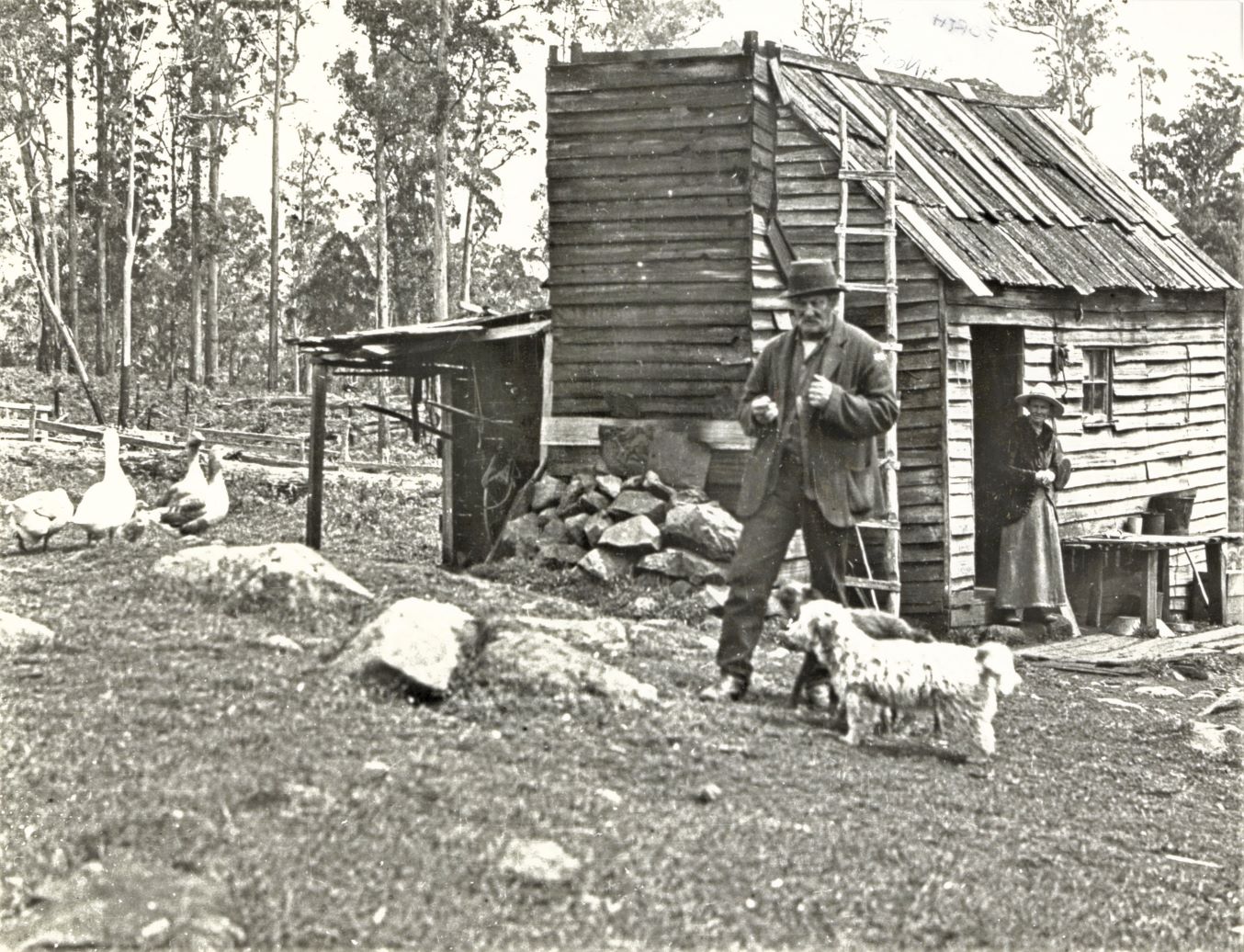
John and Elizabeth Gregson at Gisborne’s Hut in 1921. Fred Smithies photo, NS573/4/4/55 (TA).
A rolling green slope, hemmed in on all sides by great trees and roofed by the spacious sky. A streamlet purling past two little grey huts sleeping in the drowsy sunshine of a peaceful Sabbath afternoon.[24] A queer ramshackle vehicle toils up the slope and the peace is broken by a little party of Townies. The mistress of the more pretentious hut is a little wiry, shrivelled figure sharp of voice, but ready of smile and disposed to be friendly.[25] She soon has the feminine portion of the party ensconced on her doorstep listening to the finest entertainment she can offer — her gramophone. The entertainment is shared with dogs of all shapes and sizes, but alike in one respect, they are all the proud owners of a coat of thickly matted hair and buzzies. Troops of kittens tumble round but at the slightest movement in their direction they disappear under the house with the unanimity of well-trained soldiers.
As evening approaches the upper hut buzzes with life —the Townies are busily engaged settling in for the night. The wooden chimney proves to be well furnished with holes which admit the evening breezes, the said breezes being frolicsome blow clouds of smoke into the eyes of two busily making toast on forked sticks. The little breezes laugh to see a handkerchief cautiously removed to allow of lightning inspection of the toast and then as quickly replaced over aching streaming eyes. There were no regrets when that fire was allowed to die out.
Early morning sweet and fresh! Goodbye! Cavalcade sets forth led by the laden pack horses. Most inexperienced horse-women jogging gently along the beautiful winding path, filled with the deep quiet content of anticipation. The Forth gleams far below — now hiding — now shyly showing its beauty — the glint of the sun bringing out the warm tints of the mineral charged stones paving the clear stream. Presently the horse-women are footwomen by turns with a lame horse limping pain-fully [sic] behind. The pack horses far ahead — hot sunshine streaming down — Footsteps lagging a little.
****
Cool running water — Great trees offering its [sic] services as bridge — at long last the sight of a fire crackling away in the centre of the road! Pack horses minus their loads! Billy boiling! Glorious sense of restfulness pervading every inch of tired limbs stretched out on the cool grassy road. Tea! Lots of it, deliciously hot and wet! A chop, minus salt! A little bag of potatoes doing duty as a table! Our cutlery, a stick and occasional use of a penknife. But no more delightful meal was ever served. More delicious rest on the gently sloping road-side, [sic] now the useful bag of potatoes acting as a pillow. Hands clasped under head (but removed at intervals for vicious swoops at the myriads of droning blowflies floating round.) Eyes gazing dreamily into the smiling blue sky, or lazily following the movements of a tiny fluffy bird hopping and chirping in the feathery grey-green of the young wattles.
****
On once more through beautiful fens and foliage over a narrowing track, the Forth, friendly as ever, still keeping us company. At length, a steep track zigzagging up the hillside, the towers of Mt Oakleigh keeping guard above.[26]
Horseback becoming dangerous, we stiffly dismount and, seated on the rocks of the pathway, gaze with huge respect at the great towers above little thinking that before many hours have passed we will be enthroned thereon, peeping over the edge at our present lowly seat.
Through the Valley of Eden, across the flower-decked plains and, bathed in the lovely evening lights, we have our first glimpse of the circle of guardian mountains which ere long have become such familiar friends.
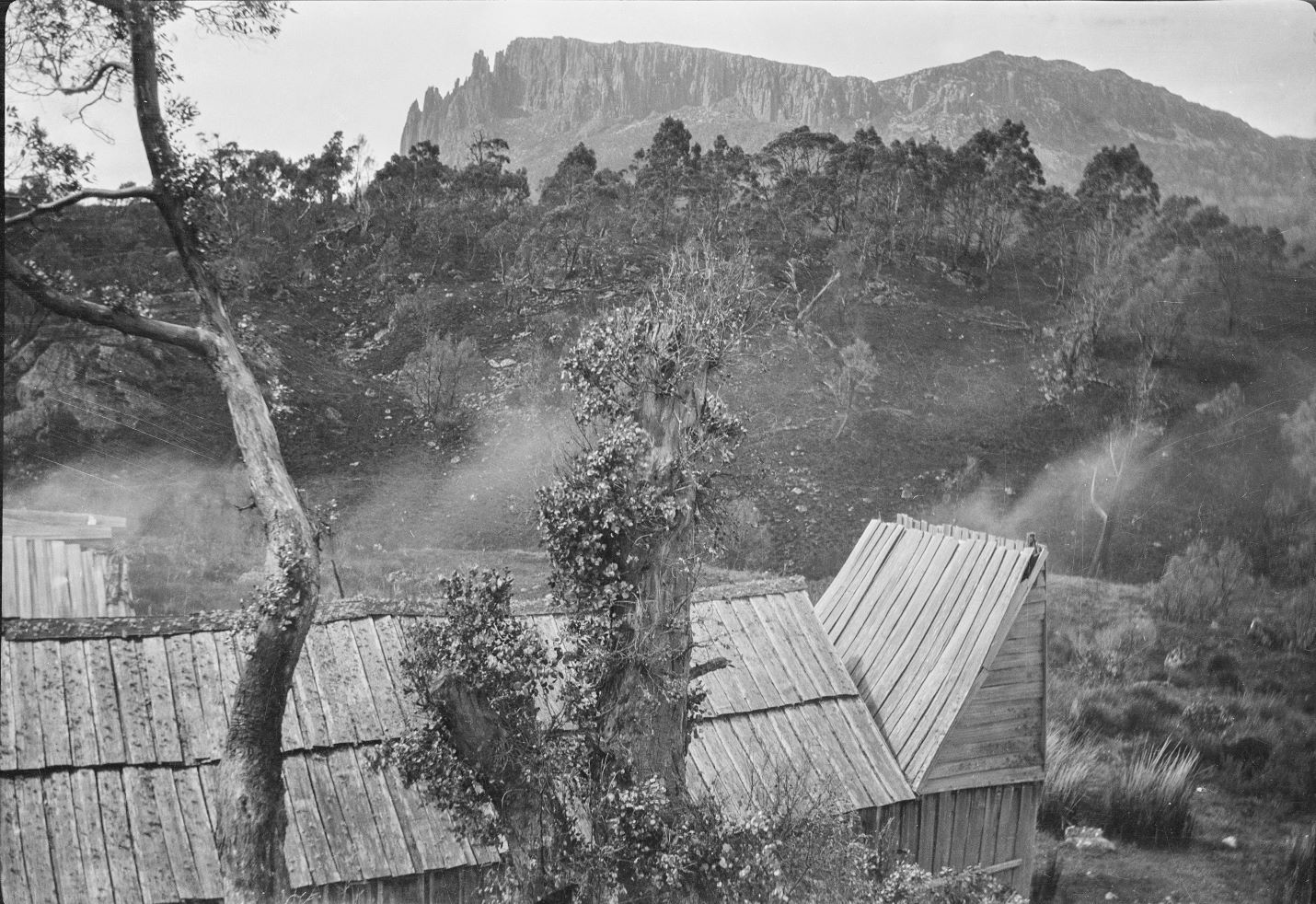
Pelion Huts in 1931, looking north, with Mount Oakleigh as a backdrop. Jack Thwaites photo, NS3195/2/1588 (TA).
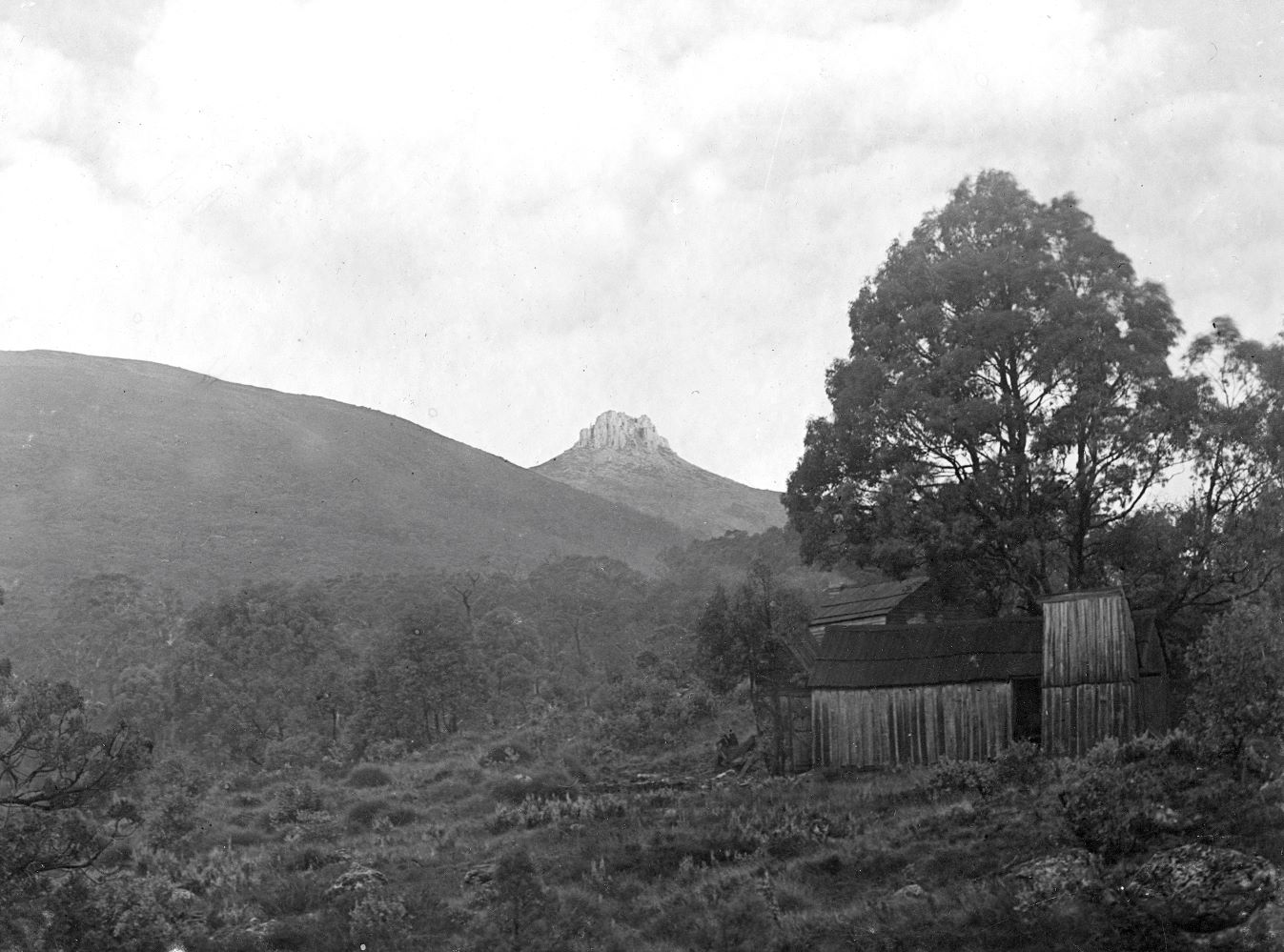
Pelion Huts looking south towards the Sugarloaf and Mount Pelion East, 1920. HJ King photo courtesy of the late Daisy Glennie.
Over the quaintest little bridge, walking on one log and clinging to another — and we are at Pelion Hut — our best loved home! In the next few days what expectant eyes it saw open on the light of a new day! What happy adventures fared forth from its portals and what tired, contented wayfarers returned at eventide!
At first we are a little put to it for lack of utensils, but as the days glide by we are the proud owners of a fine array of jam and fruit tins, which obligingly do duty as jelly molds, saucepans and all manner of things. The boxes in which our groceries were packed are just as obliging, three of them doing duty as table and the remainder as chairs.
Each morning as soon as breakfast is disposed of all are busy as bees preparing for the day’s adventure. On the table appears sundry little screws of paper containing salt, milk, powder, and tea etc; a tin of sugar, a mug of butter; the billy is packed with cups and the whole is soon transferred to the pack on Paddy’s back and off we start on the day’s tramp, cheered by the willing service of our old friend ‘billy’ and his busy little cousin ‘fizz’. When darkness falls, tired, sometimes wet, but happy, our hut sees us once more.
How bright and warm it grows under the combined efforts of huge fire, bicycle lamp, and candles stuck on tin lids. In a very few minutes the billy is boiling, the table fished from under the bunk and put together and the cloth laid (that cloth latterly of serviceable khaki relieved by small irregular splashes of white.)
Our centre piece is a paper serviette and a beautiful bouquet of Waratah [sic], ferny fronds, and graceful foliage, glorifies an empty jam tin given the necessary height of dignity by a pedestal of two tins of fruit. Our sugar basin is strangely like a mustard tin, the salt cellar strongly resembles the lid of that same tin, and they keep company with a most motley array of china, aluminium and enamel ware but we have a real teapot and a net milk jug cover, so what would you?
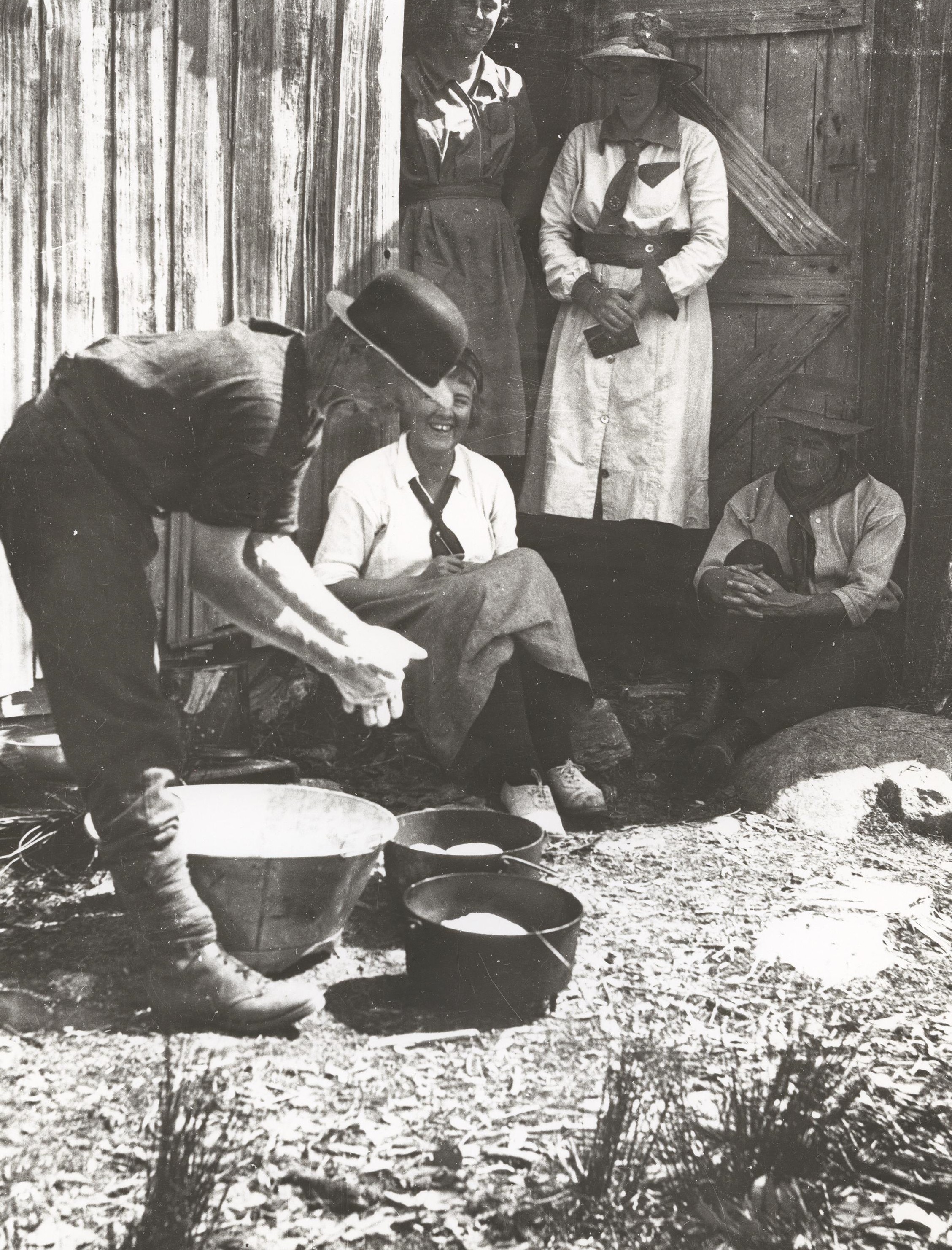
Hartnett (foreground) making damper, Pelion Huts, 1921, with (left to right) Florence Perrin (?), Edith McClinton (background in doorway), Ida Smithies (?) and George Perrin. Fred Smithies photo, NS573/4/4/1/36 (TA).
With what content we sit down to the well earned meal and when the first keen edge of appetite has worn off, push our box seats back so that the bunk supports serve as back rests, and talk and nibble nuts and raisins. Then the table is cleared, dishes washed, occasionally Paddy makes bread or we are visited by a tourist couple from a neighbouring hut, then our boxes are arranged in a cosy circle around the big rugged stone fireplace and a pleasant medley of poems, songs, and chat follows. Sometimes by the combined efforts of the whole party the whole of a song is remembered but usually one or two verses more or less mixed suffice! Even our childhood hymns have their places.
Then appears at the feet of each a cup of steaming coffee. Paddy lifts off the camp oven, ashes are scraped off, the lid is lifted, a chorus of approving voices greets the perfectly baked bread; very soon after that we are in dreamland.
****
Struggling slowly and with many a rest over the flowery plains and up lower slopes of the first mountain Oakleigh — Pushing through shady leafy tangles of vegetation richly illumined by brilliant touches of Waratah in full bloom — On the summit at last gazing our fill from one vantage point — Then being led to another and another until happy hours slip by unnoticed — The leisurely return over the plain in the wanning [sic] light — The magic of the long dreaming rest on the shores of the lakelet faithful mirror of the pearly sunset tints of the sky — Backward glances of Oakleigh now deliciously purple — Until at last the voices of the prudent are heard urging haste and most reluctantly we rise and wend our way homeward.
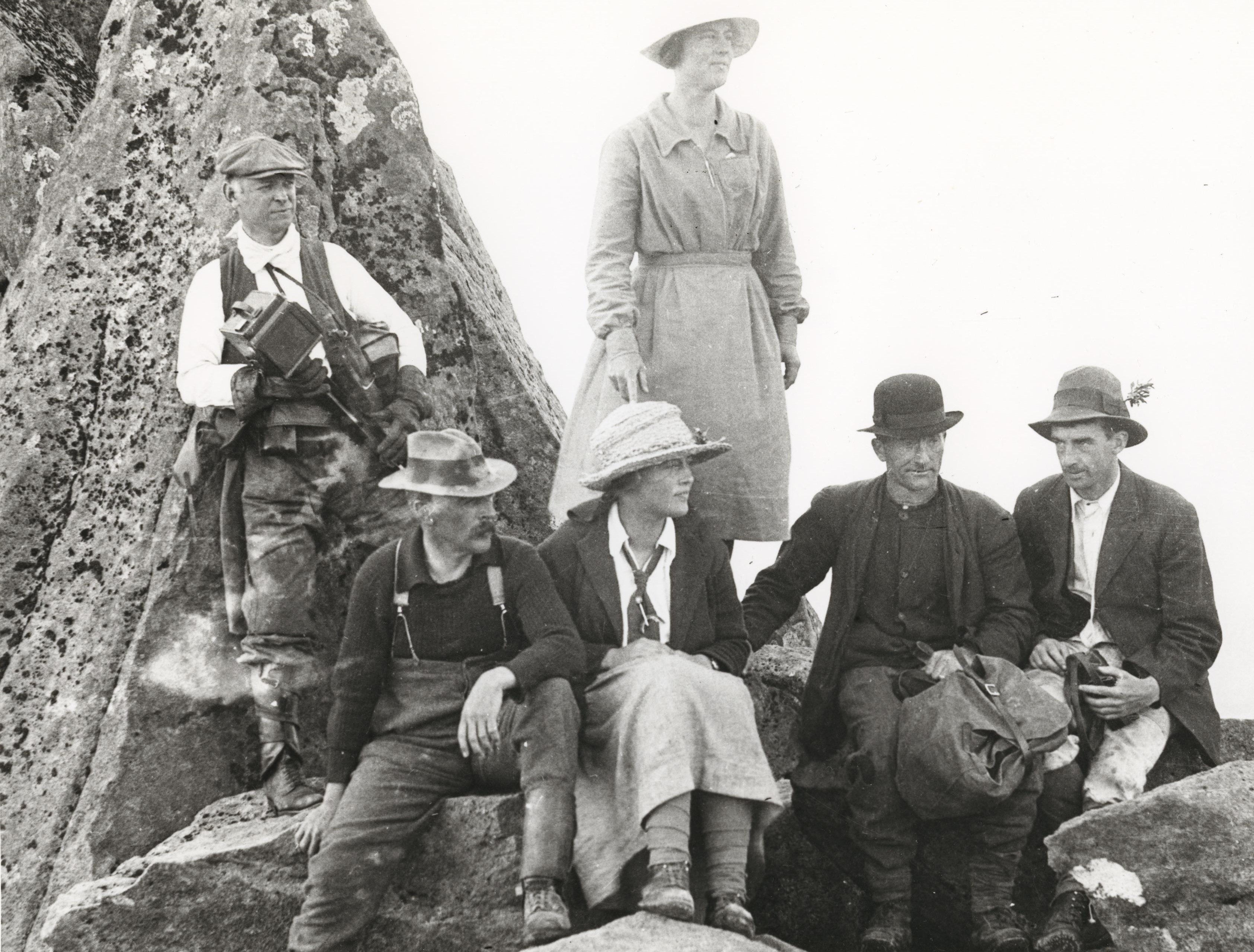
Paddy Hartnett (second from right) with a party on top of Mount Pelion West, 1921: (left to right) Ray McClinton, Frank Heyward, Florence Perrin, Edith McClinton and George Perrin. Fred Smithies photo courtesy of the late Nell Williams.
The swift rush of our descent from Ossa — The excitement of the rapid slides over the smooth snow heightened by the knowledge of great rocks and chasms and unknown depths below — Lowering ourselves cautiously down sheer drops with the friendly aid of the tough pineapple grass.
****
The rush up Thetis striving to race the driving mists to the summit — The biting wind which cuts into us whenever we come into the open — The grand piles of rock which we crawled or scrambled — The moments when we gazed helplessly at some huge heap and turned over for help that was never lacking — Places where the whole party hoisted us up or lowered us down some height — or where we walked up a ladder of human hands and shoulders. The foot reached at last in driving rain — We hastily prepared tea, cold and wet we sat down in one spot and carefully refrained from moving an inch from that partially dried and warm spot.
****
Lake Eyre [sic: Ayr] beautiful in the sunlight in its setting noble parklands. Paddy with an eye to next day’s dinner, leading gun in hand we followed in tip toe — picturesque glimpses of shy wild cattle — Tea interrupted by sudden rain — scuttle for shelter — two girls— lying flat one above the other squeezed beneath a fallen tree trunk — cosy intimate chat, eyes the while noting the lake dipling [sic, rippling?] and colour freshening on tree trunks and foliage under the rain — Contented, tramps round the lake and homeward single file in the gentle rain.
****
A leisurely stroll though plains thickly sprinkled with great daisies — where the plain ends, huge bushes of their smaller sisters greet us.
On we go up long easy slopes of springy green turf beautified by groups of large white orchids. Up here the Forth is young and frolicsome and dances gaily over little falls, turning and turning between beautiful pines that give it quite an alpine touch.
But we have a thought for tomorrow’s dinner despite the beauty surrounding us and keep a wary eye on the joyous flocks of jays noisily chattering overhead[27] — Girls still as mice! Vicious snap of Paddy’s gun! Quick downward fall of mute little body! Reckless plunge of men into the undergrowth! Triumphant return with one more trophy, and so on.
****
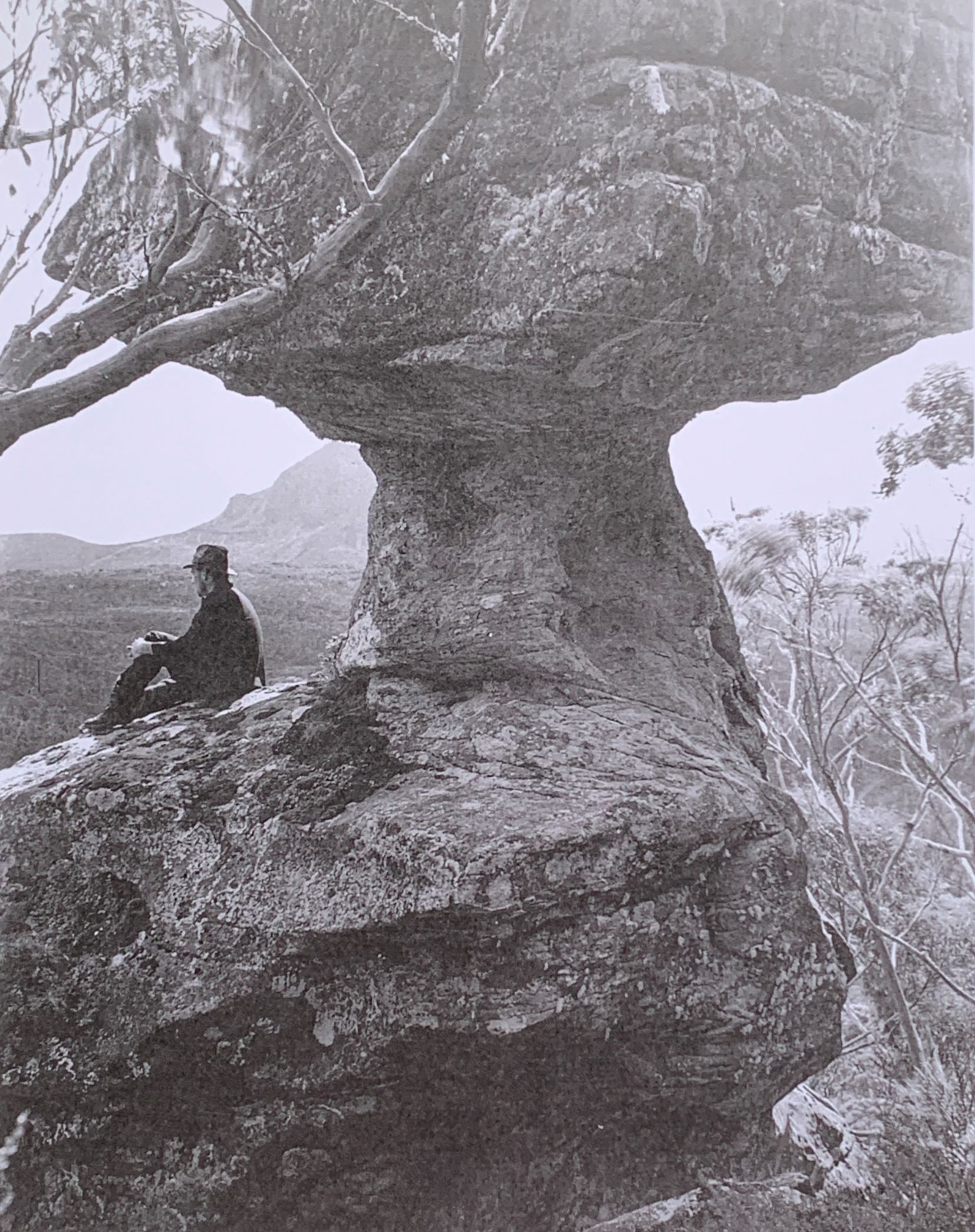
Toad Rock under Mount Pelion East. HJ King photo courtesy of the late Daisy Glennie.
Soon we are gazing on Pelions [sic] giant toad standing on his pedestal on guard, gazing across the tree tops over the hills and far away.[28] We cast wistful glances at Pelion so tantalisingly close, playing hide and seek with the mists; but time and the weather are against us, and we leave him unconquered.
****
One more pleasant picture that day holds — one suggesting Canadian backwoods. A lichen enamelled forest of giant Myrtles [sic] and King Billies, little streamlets making music through tis ferns and mosses — Hidden securely in its heart most picturesque Crusoe huts.[29]
****
Great fire! Billy boiling! Firelight flickering on weary party soon utterly content! Vacuum filled! Thirst quenched! As giants refreshed we rapidly make for home sweet home in the fading light.
****
Our sunshiny day off! A tap awakens us, the door opens, the sunlight streams in! Enter Paddy! Fire alight! Billy boiling! In a trice we are slowly sipping fragrant coffee and nipping biscuits, our eyes feasting on our one picture — a panel of Mount Oakleigh framed in the open doorway. Exit Paddy! Back we lie in luxurious idleness while light-hearted chatter and snatches of song are tossed back and forth through the pine wall.[30]
Leisurely toilet! Leisurely breakfast! Most leisurely household duties! Contented heaping of all culinary responsibilities on capable manly shoulders. Leisurely stroll down to the Forth,[31] very young and pretty between its steep banks. Soon in that secluded spot appears a softly rounded mermaid, splashing joyously in the crystal stream — smiling face and soft brown eyes radiating sheer joy in life. All too soon, alas, she has disappeared, and two commonplace mortals climed [sic] the bank to bask in the sunshine, exchanging low-voiced confidences until a much-uplifted voice summoned them to a wholly unearned, but much appreciated meal.
****
Reluctant farewell to our Pelion Hut, steps retraced with many a backwood [sic] glance! Eyes a fortnight older lingering on remembered scenes. Wolfram! Cautious feet exploring the damp dark mine tunnel![32] Dinner and brief rest at the miners’ huts. On! Over the Forth! Through luxurient foliages! [sic] Through black oozy mud, cautiously skirting the edges of the track at first in the vain endeavour to escape it — then plunging recklessly through it feeling it coldly oozing through the laceholes [sic] of our boots and squelching between our toes!
****
On up the razor back![33] Heats jumping! Breath coming quickly! Loose stones slipping beneath our feet. Ever slower and more slowly in the gathering dark until the pack horses have long disappeared in the gloom above. At long last Paddy and the horses (minus their loads) reappear and the day ends with a mysterious ride in inky darkness. We hear our horses splashing through the water but we cannot see it — we feel branches of trees brushing us as we pass, but these also we cannot see. Perched up on the sky line, we feel like Rebecca on her camel going to meet her lord. All we can see is a black sky far above, pierced by little steel stars. The cool evening air is soft on our faces, and we feel the exquisite luxury of transport on feet other than our own tired ones. Our journey ended, the new hut provokes a smile.[34] The fireplace end is missing and provided easy exit — also access to all and sundry. The floor is thickly strewn from end to end with dry brush etc, but Paddy’s broom of twigs soon sets that to rights. Willing hands have soon unpacked necessaries and gathered our fragrant leafy mattress after a hasty meal on a table which is a most ancient and feeble shell of grey paling which the slightest touch sends askew. An attempt to introduce an extra support shook it so alarmingly that the attempt was abandoned with a fervent prayer that it might outlast our need.
****
Paddy’s voice calling us next morning provoked most dismal groans, but soon we were busily engaged in making preparations for our visit to Cradle of happy memory. Trustfully we leave all but absolute necessities to the mercy of the ‘possum and their friends, and are on the tramp once more.
****
Seated above the wonderful wide sweep of a great cirque, two girls are having shooting lessons, a lovely spray of Blandfordia beside them surveying the performance with wondering eyes.
****
A line of wayfarers pushing rather wearily up seemingly endless slopes thickly clad in a ghostly pale grey thicket of leafless stunted bushes, extraordinarily tough and wiry, its pale skeleton fingers clutching spitefully at our garments as we press through it.
****
A grassy hillside thickly spotted with spikes of pretty pinkish flowers — fly-catchers. Paddy holds a flower in one sunburnt hand — a tiny piece of dry grass in the other. A group of figures kneel round him on the grass, eyes fixed on the flower. Its centre is touched! Down comes the fairy hammer! Little starts! Little exclamations! Peals of laughter! More hammers fall! More starts! More exclamations! More laughter! And so on ad lib.
****
The precious gun and our food are securely hidden in the bushes. Then onward round the white pegs at the base of Cradle, eyes eagerly searching for familiar landmarks. Once round Cradle we allow ourselves one long backward glance at Barn Bluff, softened and beautiful in the deep purple shades of evening, and then on we push. A glad cry announces the first sight of old Waldheim nestling among its pines. We descend the hill a little too far to the left and find ourselves in thick scrub, but on we rush, pushing through clinging branches, jumping, scrambling, anyhow, for we must reach Waldheim before dark actually falls.
Across the plain we break into a quick run — up the hill, round to the kitchen door — the familiar bark of Flock announces us — open comes the door, and we have the hearty surprised greeting of Mine Host.[35] We just have time to note a huge new woodshed facing the kitchen door, when we are swallowed up in the light and warmth. In a very few moments we are round the old table, attending to the needs of the inner man, and making the acquaintance of the other visitors. Then into the cosy old fireplace, chatting and listening to records, old and new, and off to the tent room to long dreamless sleep, buried under piles of grey blankets.
****
Morning! Bright sunshine! Breakfast! Friendly talk! Farewells!
****
On the trail once more! Rest on lovely green fairy mounds starred with tiny daisies. Crater Lake — still — mysterious — deeply, darkly blue — Dove Lake — sparkling dancing in the glorious sunlight. As we climb, many a backward glance is cast at Waldheim nestling in its valley and farewell cooees reach us, softly floating across the distance. The last thing we see as we disappear over the top of Cradle is a friendly white signal waving, and then we set to work in earnest to reach our hidden food.
But the day is far spent when at length it is reached and a silent and empty party sit down to the long deferred meal. But very soon our good friend ‘Billy’ works his magic beneficently as ever, and we laugh once more.
We are seated on the ridge between Cradle and Barn Bluff— those stately old giants gazing serenely over our heads in the soft evening light. One whose face is crimson with sunburn, produces a battered tube of lanoline wrapped in worn brown paper having a goodly share of lanoline upon it. With this paper he proceeds to anoint his burning face. A girl, equally crimson of visage, rummaging among a tiny stock of treasures produces a jar of face cream. Apparently the jolting of the trip has caused the cream to spread itself outside the jar. With this she economically proceeds to anoint her face. Something strange about it invites hasty investigation and with utmost horror she finds she has carefully rubbed tooth-paste [sic] upon her cherished countenance. And those hoary old giants suffer not a wrinkle in their old faces to twitch during the unseemly and ridiculous mirth that follows.
****
Rapidly we push on, but all too soon black darkness is upon us. Closely, blindly we follow in Paddy’s footsteps slipping, stumbling, over bogs, tussocks, stones, seeing not an inch in front of us except where the gleam of water shines warningly. At length rest becoming imperative, we stretch wearing limbs on the cool earth, gazing into the starlit immensity above. Voices break the silence ‘Can you see the duck?’ — minute directions — mystified eyes vainly straining. ‘See the handle of the saucepan — now the sweep of its breast!’ Triumphant laughter! ‘Acres of duck!’ ‘A bonza duck.’ ‘Pooh! It’s a brimming old duck!’ Then mightily refreshed by the sight of that duck we resume our stumbling march! The top of the hill is reached and soon home sweet home with the fresh night blowing through it.
****
Refreshment! Our leafy couches — and Silence.
****
Breakfast in bed and one more lazy sunshiny day of roaming round our hut and the next day we depart! The pack horses have disappeared — absolute necessities are packed and the bulk of the luggage left behind for those most foolish horses on their return up the razor back. This time we have leisure and light to see the beauties bordering the steep track and at the hill’s foot come upon our truant horses returning in charge of the packman. Most gladly the packs are shed and left in the pathway to be picked up.
Through sun-flecked paths the giant bracken bending low and caressing us as we pass we reach the beautiful Forth once more and hot and tired we clamber down its bridge supports to lunch on the cool flat stones in the shade of giant leatherwoods, one mass of beautiful bloom. Here the river is broad and deep and we sit in luxurious coolness watching its smooth flow until the word to march on.
****
Our first hut once more — We now recognise it as a palace with its real glass window and movable table and bunks — wallaby patties made by Paddy — then a visit to our friendly old lady, this time in most wretched and squalid sickness. A nightdress of indescribable hue hangs on her thin form and she is covered by a few soiled and tattered rags; no single sweet or fresh thing to be seen — lack of every little refinement to lighten sickness. On the walls are the only things that might attract attention — every inch of them is covered with magazine cuttings and girls, dogs, horses, all manner of things stare at the poor frail old form. When we left the listless eyes were a little brighter, and in our hearts was a deep pity for all lonely bush women, and especially all sick ones.
****
By dinner time next day our driver and a visiting surveyor had joined us, and we all sat down to our last bush meal — bully beef and onions — with borrowed cutlery added to our already motley collection.
****
One evening the moon looked down and saw the dear little fluffy nurse and the new Doctor [sic] climbing the steps to the ‘Eagles Eyrie’. Now, those steps are steep and the little nurse is plump, so is it any wonder that presently they sat down upon a step instead of climbing it?
When the little nurse got back her breath the moon heard in regretful tones, ‘Our pretty patient leaves to-morrow’. ‘What in the world did you do to her to-day? She looked as if she had got hold of the Elixir of Life.’ [sic] ‘I guess she had’ said the girl softly, ‘And he must have had a dose himself too, judging by the look on his face when he left.’ ‘Well! He’s a lucky chap!’ said the man heartily, ‘Who is he?’ ‘P Lane was on his bag.’ ‘Jerusalem! It must be old Percy! Used to know him at school. His dad lost a lot of money in that Barn Bluff oil show. Met him to-day, and he told me he had struck it lucky — in more ways than one it seems, but he didn’t mention that.’
[1] That is, the old two-chimney Mount Pelion Mines hut that stood below Old Pelion Hut and fell down in 1948.
[2] ET Emmett, ‘Scenic reserve: memorable week’s tour: Cradle Mountain to Lake St Clair: Hobart party’s experience’, Mercury, 10 January 1931, p.2.
[3] See ‘A dip into the Waldheim mailbag’.
[4] NS573/1/1/11 (Tasmanian Archives, afterwards TA).
[5] Years are from headstone, Carr Villa Memorial Park, Launceston; plus 1901 British Census as below.
[6] British Census, 1901, Administrative County of London, Civil Parish of Heathorn, p.22 (accessed through Ancestry.com.au).
[7] Electoral roll, Division of Bass, Subdivision of West Launceston, 1922, p.48. See also will of Henry Sidney Scott, in which he made his daughter Vera May Scott his sole executrix and beneficiary, will no.18727, AD960/1/56 (TA).
[8] ‘Thanks’, Examiner, 23 October 1945, p.2.
[9] See will no.43508, AD960/1/94 (TA).
[10] Years are from headstone, Carr Villa Memorial Park, Launceston.
[11] Passenger list for the Orana, October 1891, Series BT27, British National Archives (accessed through Ancestry.com.au).
[12] Electoral roll, Division of Bass, Subdivision of Launceston Central, 1922, p.34.
[13] Electoral roll, Division of Bass, Subdivision of Launceston Central, 1968, p.16.
[14] Descriptive list of immigrants, ss Coptic, arriving in Hobart 27 July 1888,. CB7/12/1/12–13, p.40 (TA), https://librariestas.ent.sirsidynix.net.au/client/en_AU/names/search/results?s=harriet+cumings&searchTarget=library&qu=harriet&qu=cumings, accessed 10 June 2023.
[15] ‘Current topics’, Launceston Examiner, 13 May 1893, p.5.
[16] See, for example, ‘Education’, Launceston Examiner, 4 January 1893, p.2; ‘Educational’, Daily Telegraph, 21 January 1896, p.4; ‘Diamond jubilee’, Launceston Examiner, 15 June 1897, p.6.
[17] Married 21 January 1903, registration no.608/1903, at St Paul’s Church, Launceston (TA).
[18] John Gregson’s headstone details are recorded on the Lorinna Cemetery page, Kentish Museum Trust, All known burials in the Kentish Municipality, 2nd edn., 2007. Elizabeth Gregson’s patient admission record for the New Town Charitable Infirmary on 5 August 1926 is HSD274/1/1 (TA), https://librariestas.ent.sirsidynix.net.au/client/en_AU/tas/search/detailnonmodal/ent:$002f$002fARCHIVES_DIGITISED$002f0$002fARCHIVES_DIG_DIX:HSD274-1-1/one?qu=%22hsd274%2F1%2F1%22, accessed 13 October 2019. Her age was given as 73 years. She never left this institution. Her date of death is also recorded there on 11 June 1927, death record no.1656/1927 (Tasmanian Pioneers Index).
[19] In the Weindorfer diaries the only instance of a party arriving at Waldheim from Commonwealth Creek/Lake McRae is Fred and Ida Smithies on 18 April 1927. They went around the eastern side of Cradle via Lake Rodway, but returned to Commonwealth Creek/Lake McRae via the western side of Cradle on 20 April 1927.
[20] Gustav Weindorfer diary, April 1922, NS234/27/1/8 (TA).
[21] The new woodshed was completed 7 August 1923, the tent room was finished 2 December 1924, Gustav Weindorfer diary (Queen Victoria Museum and Art Gallery, afterwards QVMAG).
[22] Gustav Weindorfer diary (QVMAG).
[23] Gustav Weindorfer diary 9 May 1923 and 13 October 1926 (QVMAG).
[24] The author describes travelling south on Patons Road towards the Wolfram Mine on the upper Forth River. The two huts were Gisborne’s Hut, owned by Hobart schoolteacher, orchardist, journalist and political commentator Frederic (FAW) Gisborne, and a hut nearby which was built by Mount Pelion Mines. The Gregsons appear to have occupied the former until the mining hut became available in 1921.
[25] The woman described is Elizabeth Gregson. For the full story of John and Elizabeth Gregson, see Simon Cubit and Nic Haygarth, Historic Tasmanian mountain huts: through the photographer’s lens, Forty South Publishing, Hobart, 2015, pp.100–105.
[26] The author describes the Zigzag Track, the pack track between the Wolfram Mine and the Pelion huts.
[27] ‘Jays’ or ‘black jays’ are currawongs.
[28] Toad Rock, under Mount Pelion East.
[29] A reference to the Crusoe Hut in Cataract Gorge, Launceston, a rustic hut established on the main walkway in 1893 as a reference to Daniel Defoe’s 1719 novel Robinson Crusoe, about a castaway marooned on an island off the coast of Venezuela.
[30] The larger hut at Pelion Plain, the two-chimney workers’ hut, was built of eucalypt. ‘Pine wall’ confirms that the hut the author slept in was the mine manager’s hut, now known as Old Pelion Hut.
[31] That is, Douglas Creek.
[32] The main adit of the Wolfram Mine, aka the Mount Oakleigh Wolfram Mine. Wolfram (tungsten) had been needed for munitions during World War One but after the war ended the price of tungsten dropped and the mine was abandoned.
[33] The notoriously steep Razorback Track between the Forth River and the Barn Bluff Copper Mine.
[34] Probably one of the huts at the abandoned Barn Bluff Copper Mine at Commonwealth Creek.
[35] Gustav Weindorfer, proprietor of Waldheim Chalet 1912–32.





























